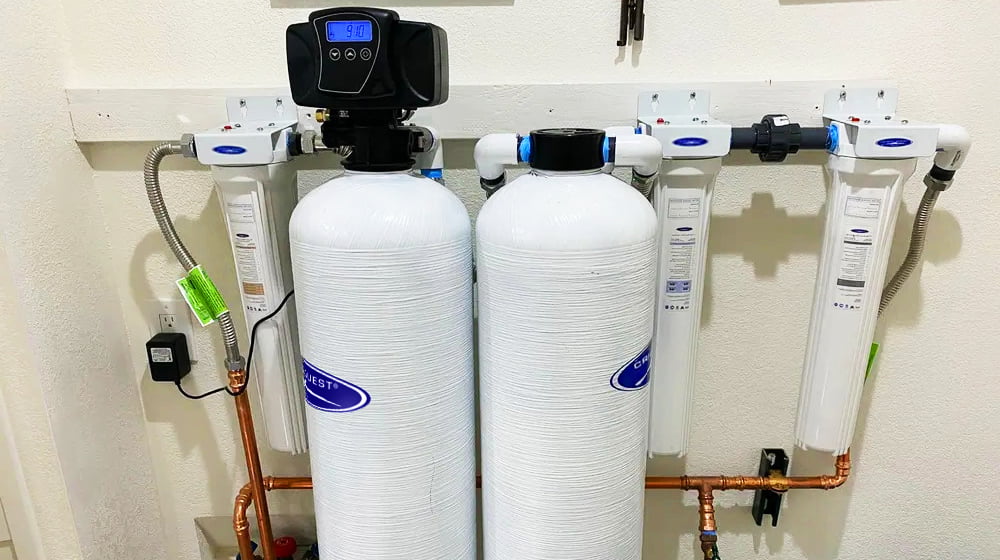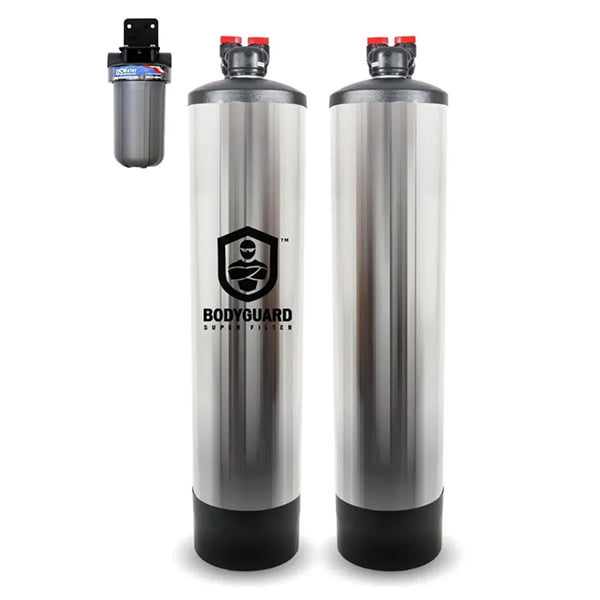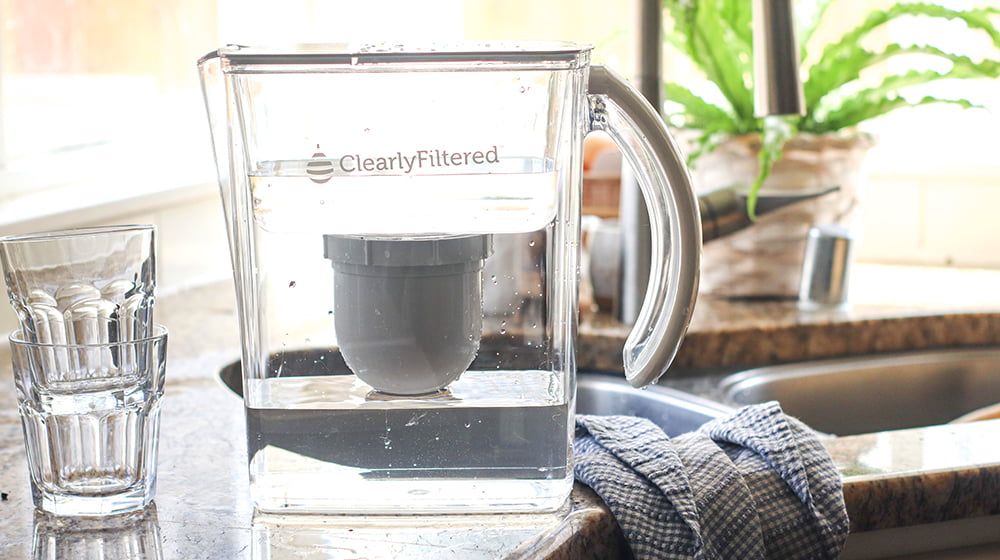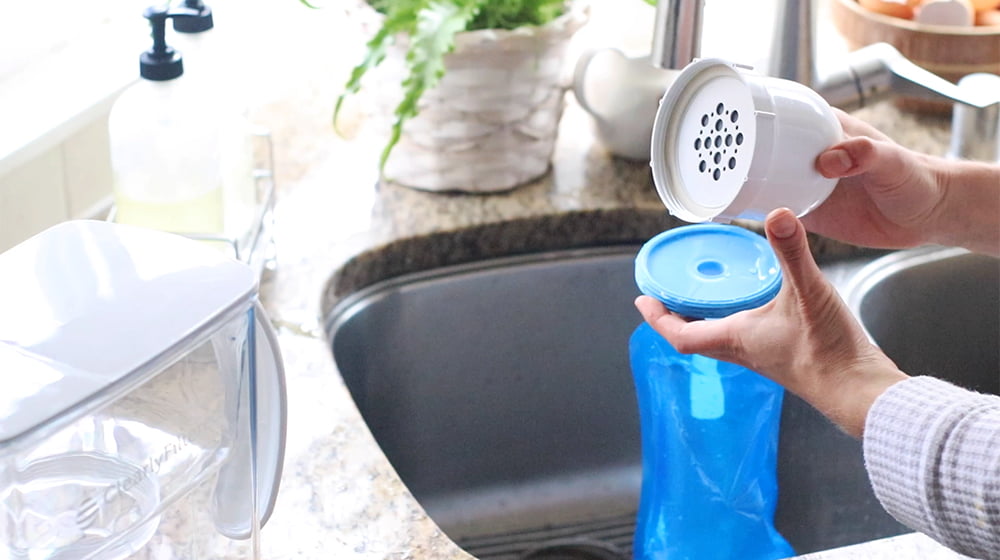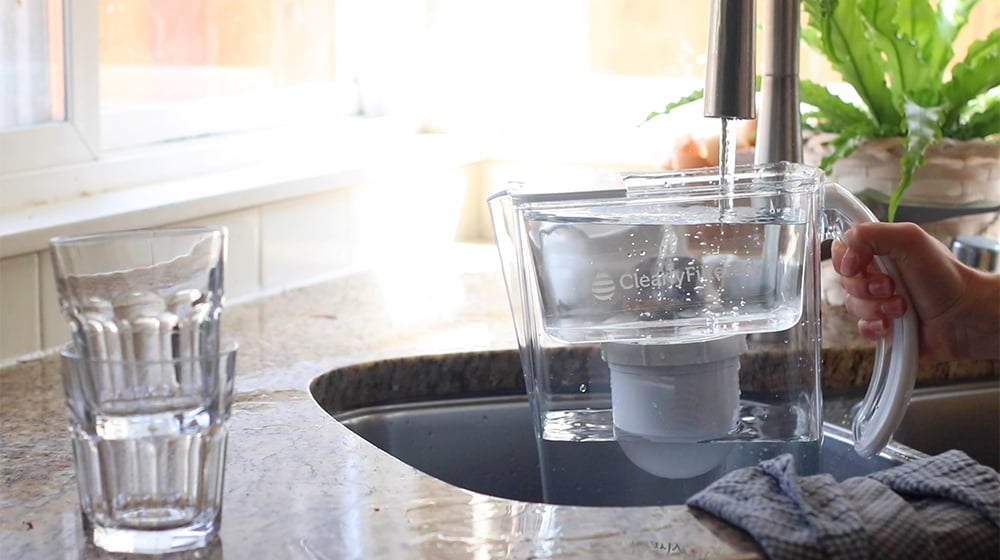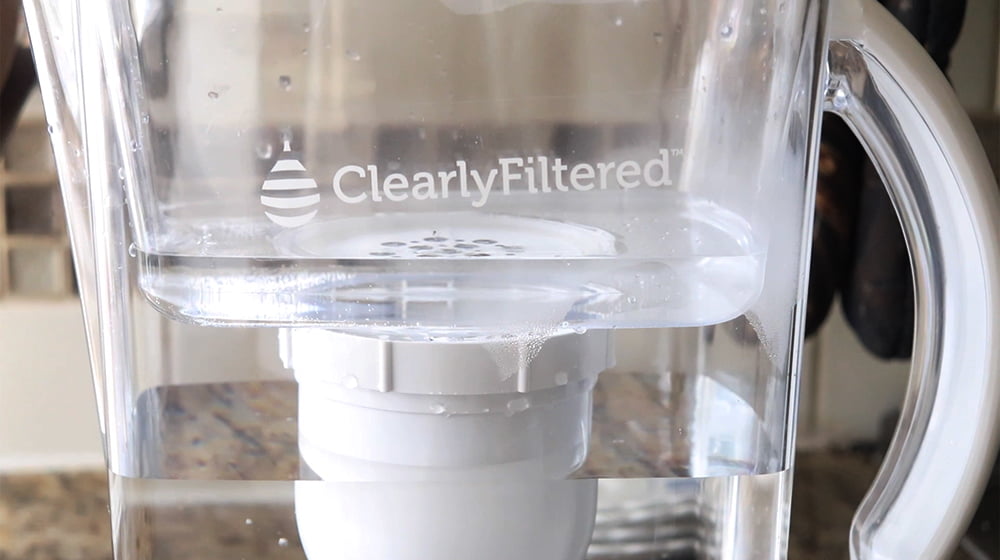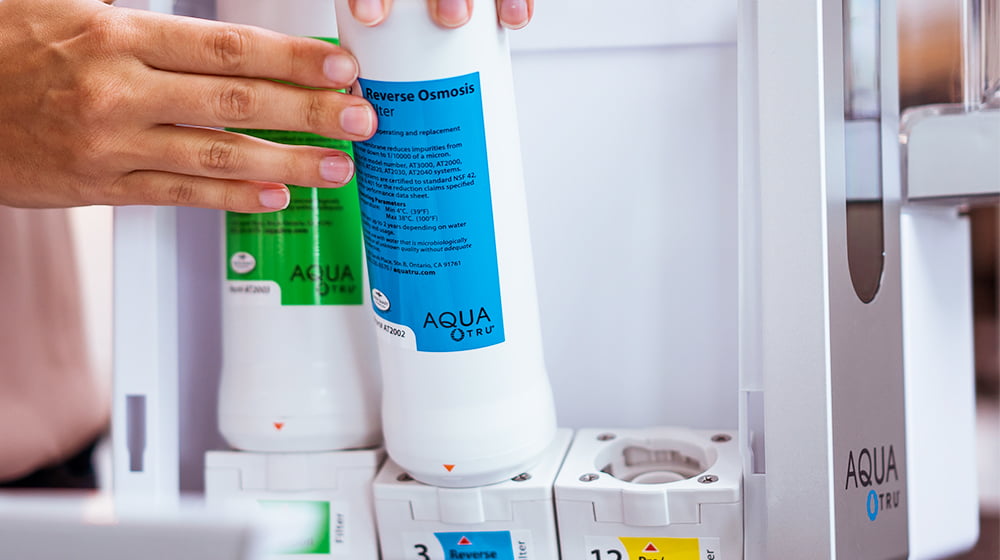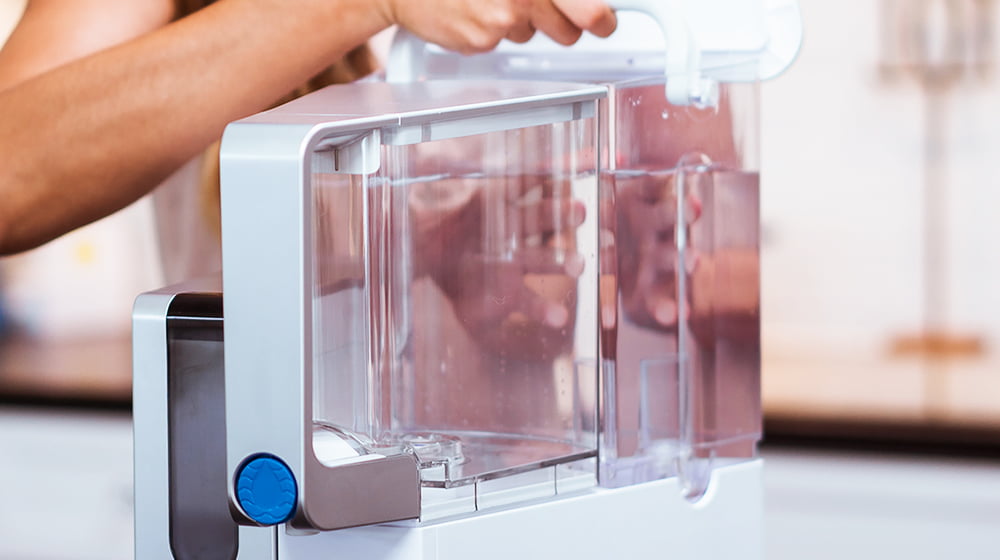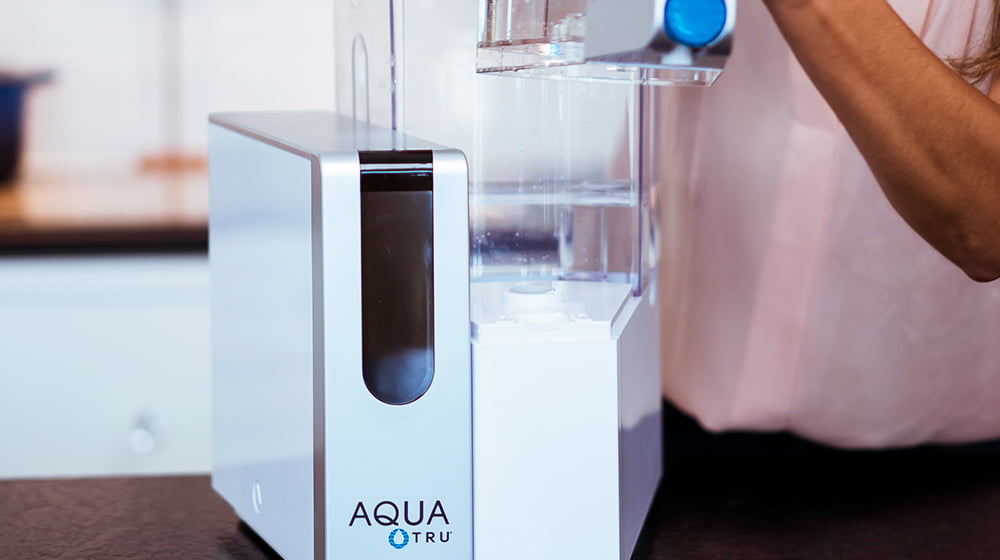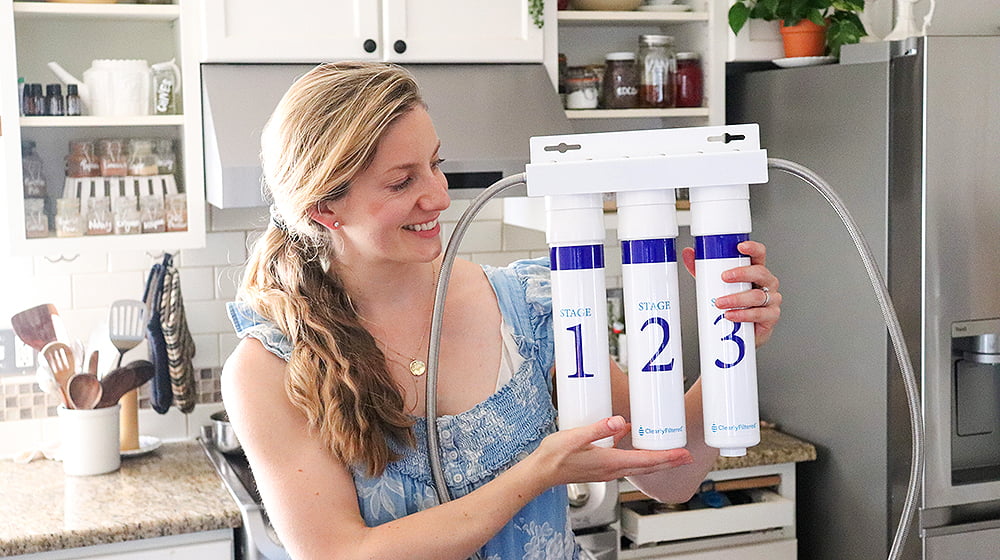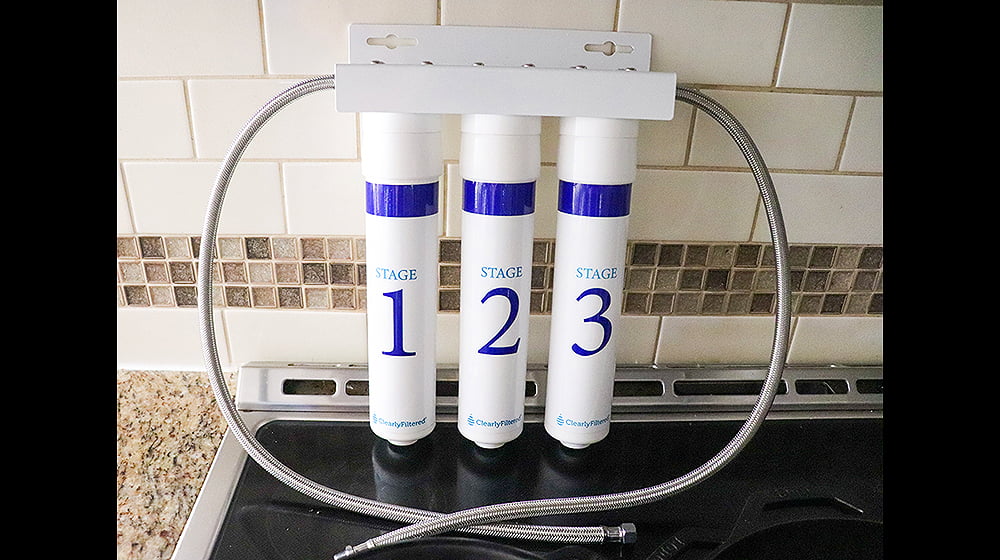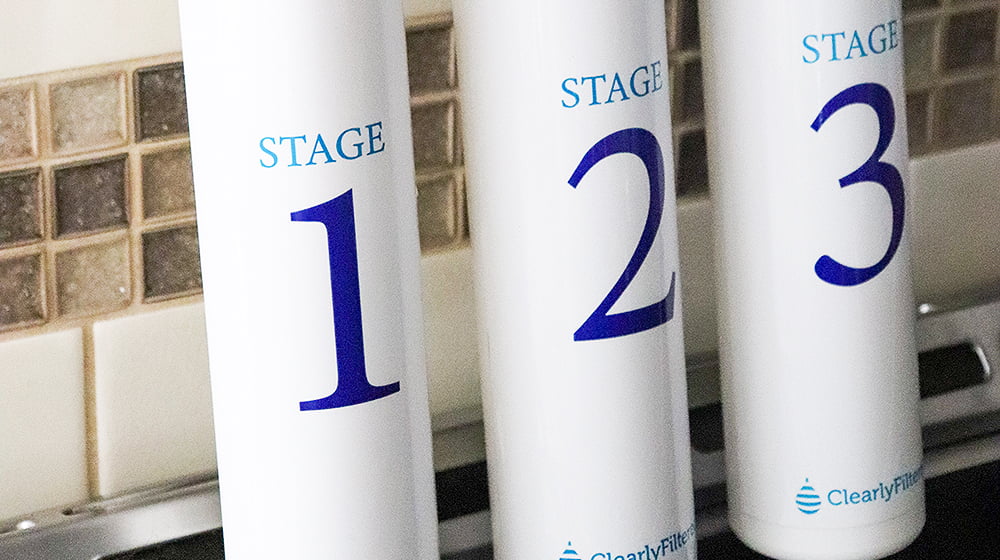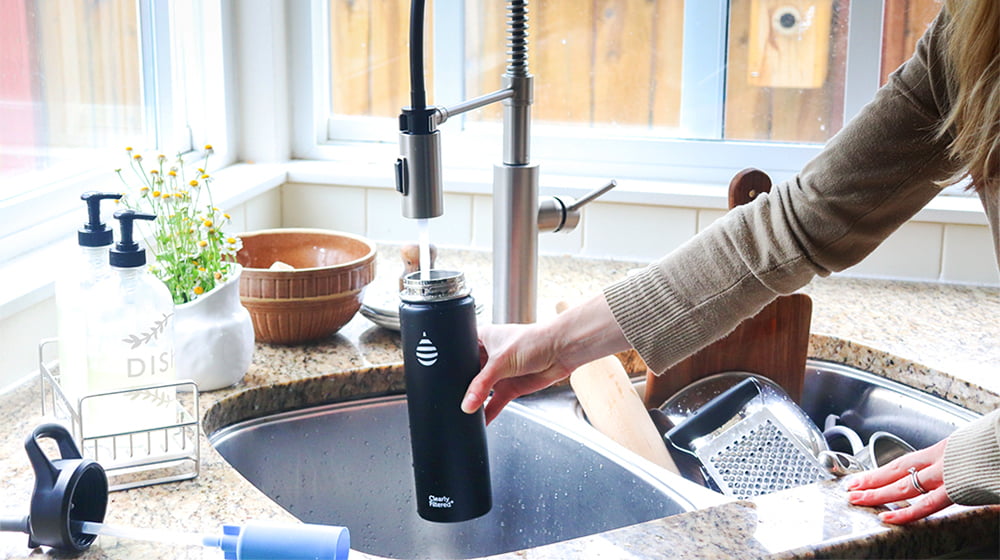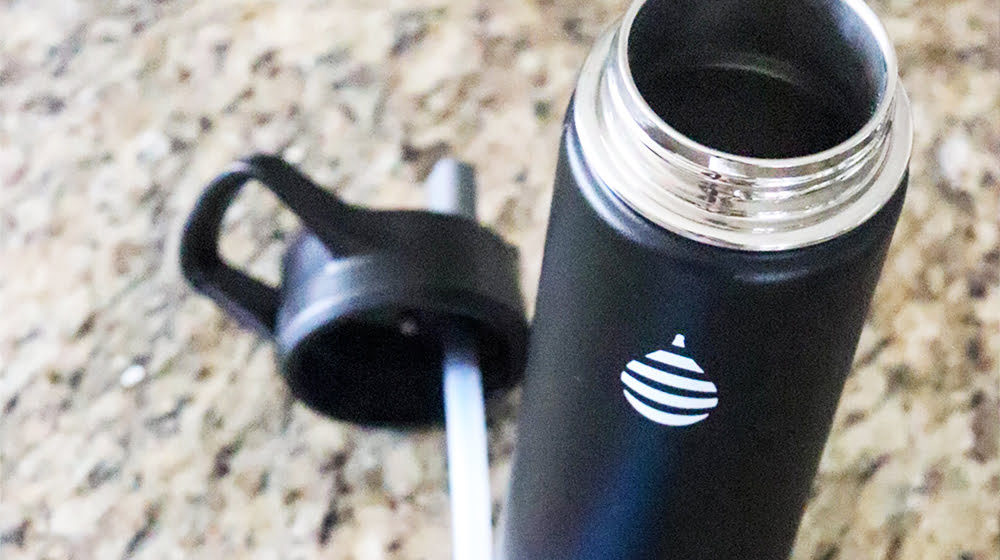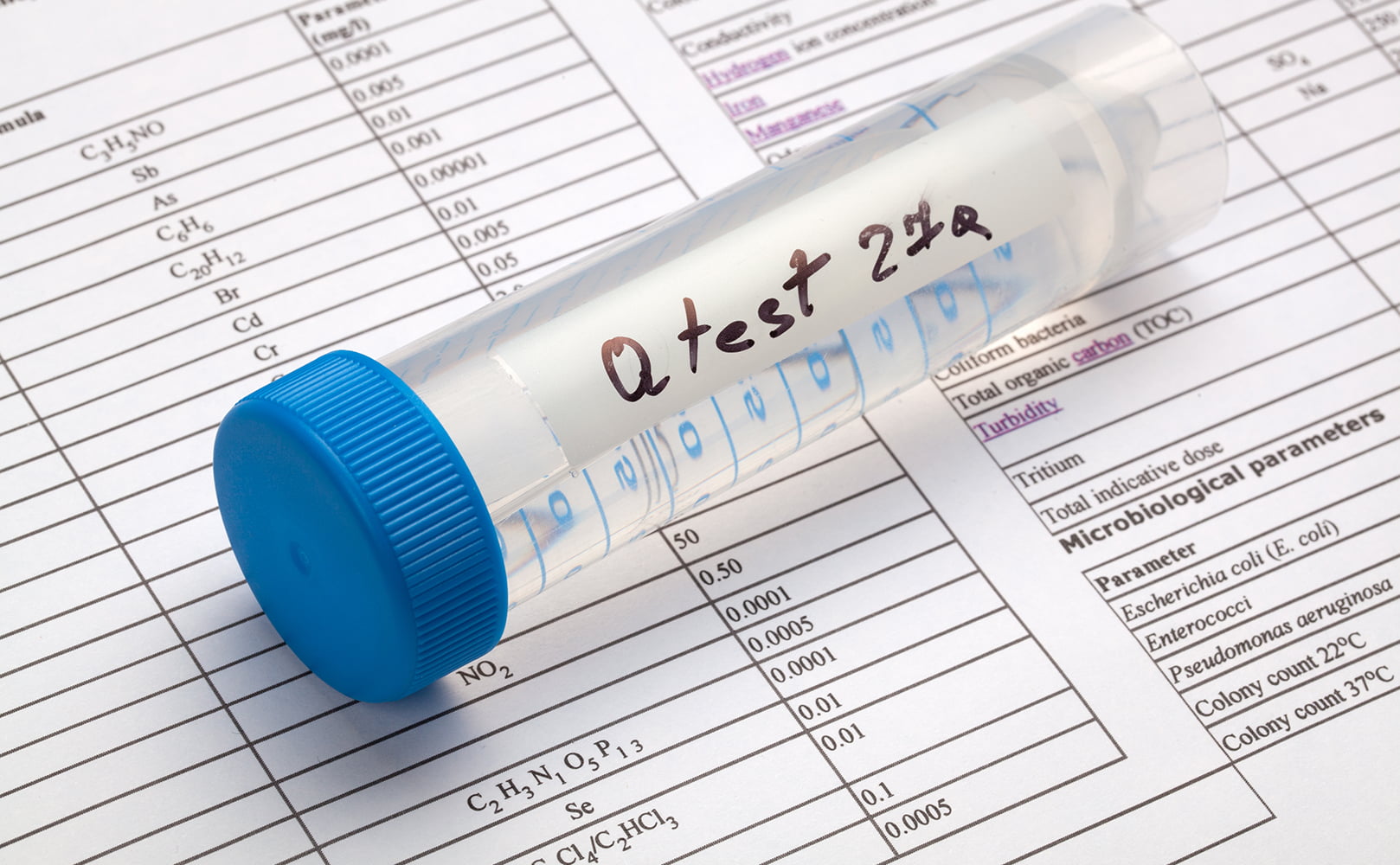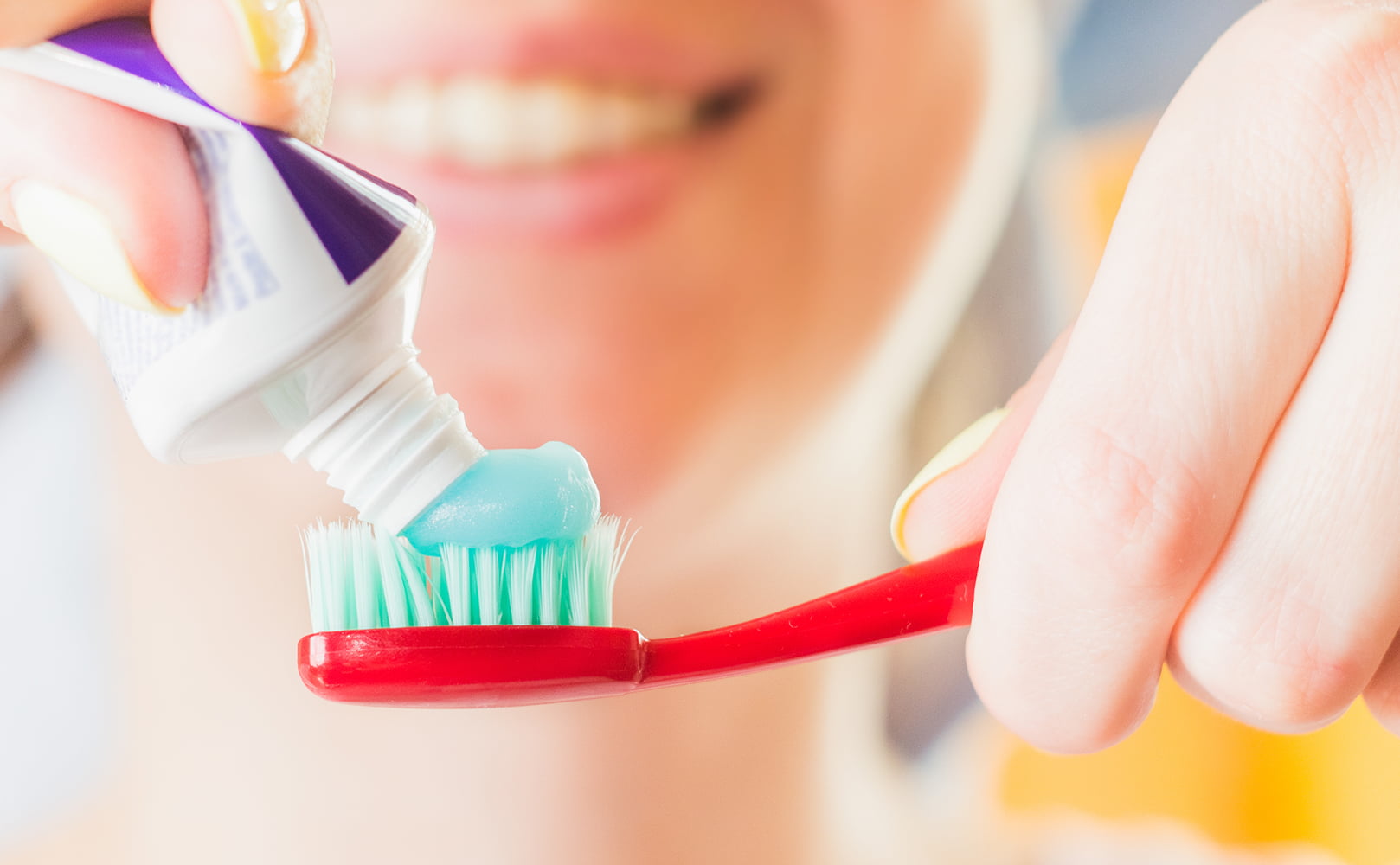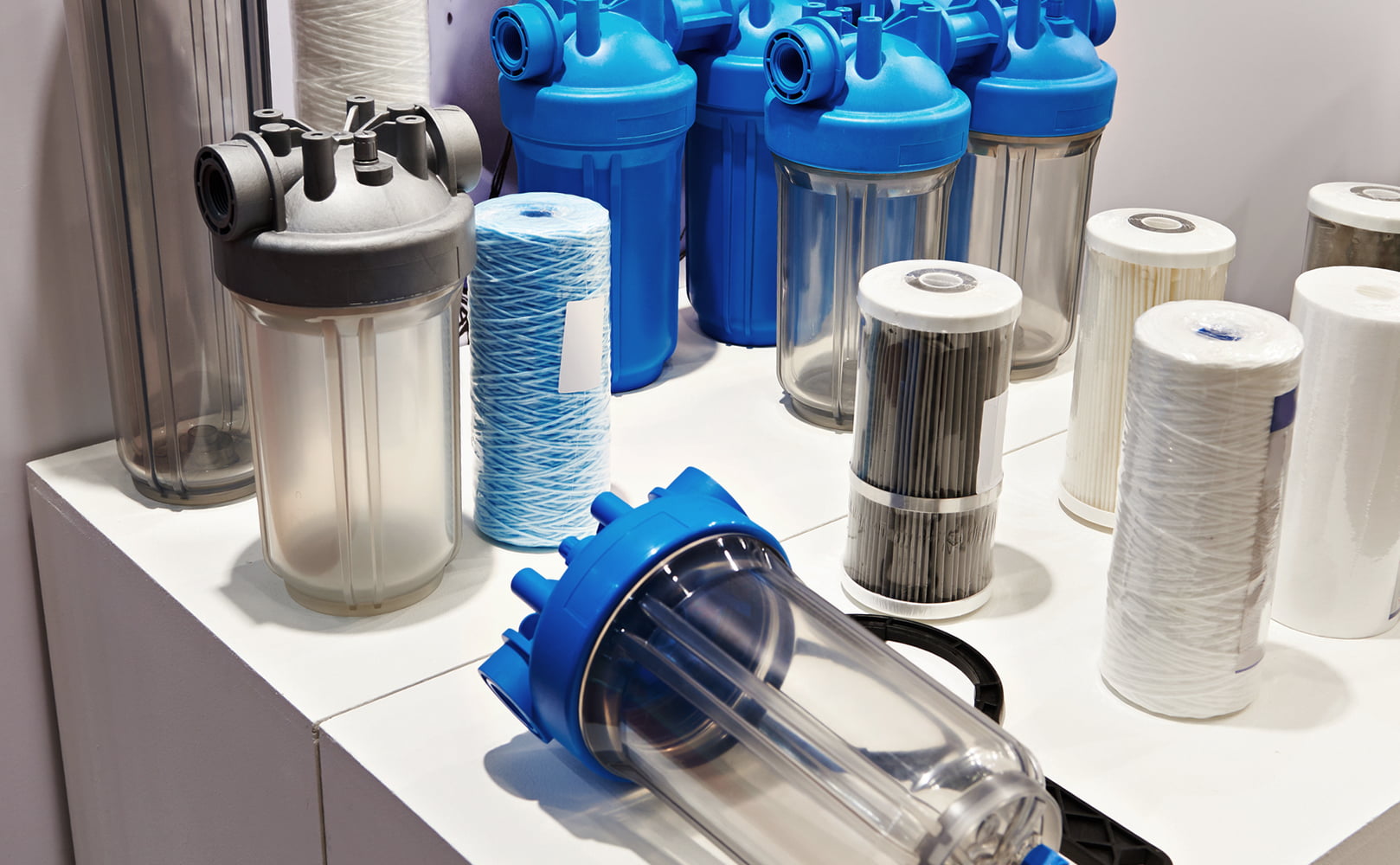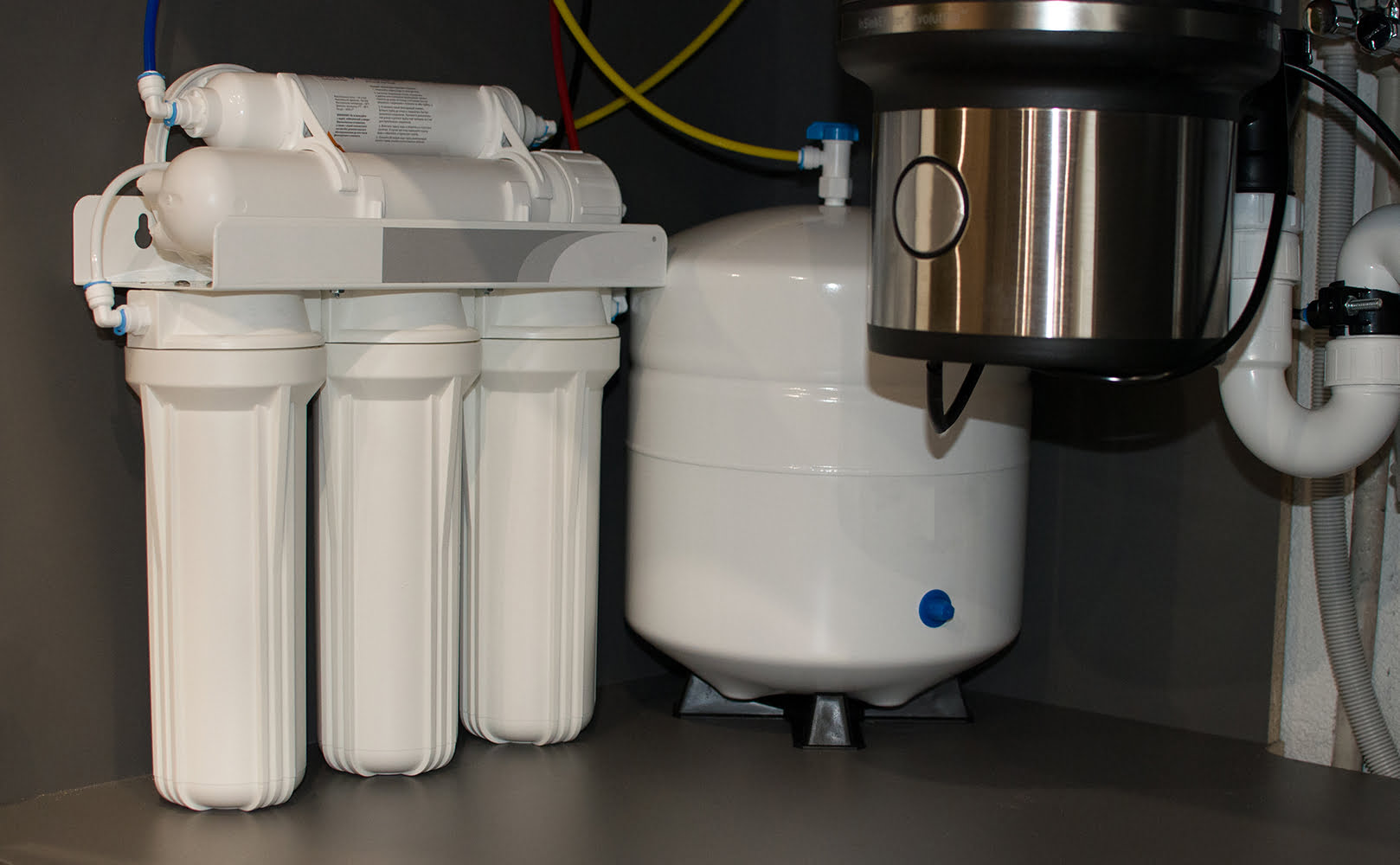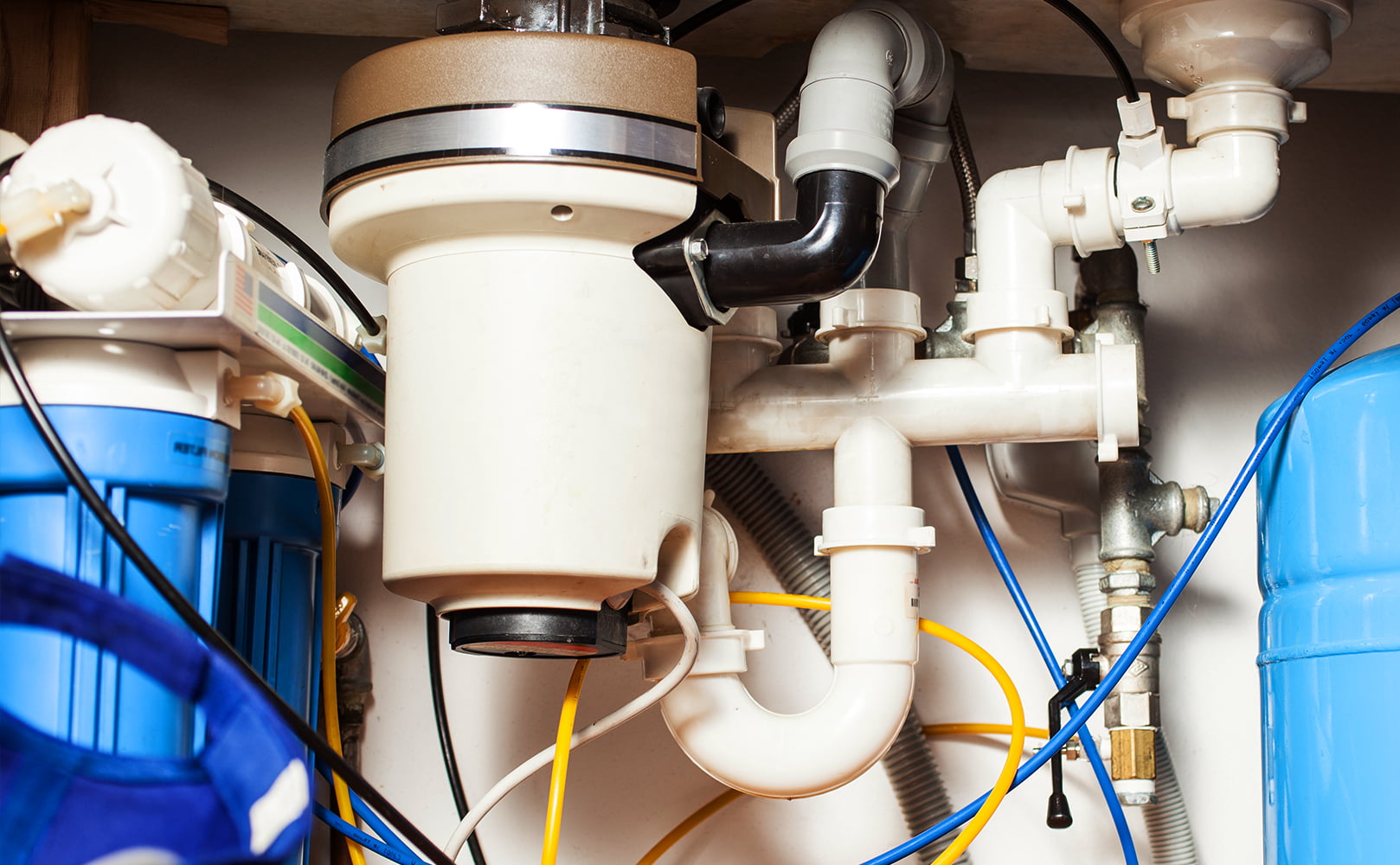10 Best Water Filters to Remove Fluoride and Chlorine *Update 2024
Written by: Gene Fitzgerald // Expert Fact-Checking: Buddhini Dolapihilla, MBSS // Last Updated: Jan 31, 2024
This page may contain affiliate links. If you buy a product or service through such a link we earn a commission at no extra cost to you. Learn more.
Top Pick: What’s the Best Water Filter to Remove Chlorine and Fluoride?
The best water filter to remove chlorine and fluoride in 2024 is the Clearly Filtered Pitcher. It is NSF-tested to remove 99.5% of both chlorine and fluoride among hundreds of other contaminants. It is also easy to set up and use, affordable to maintain, has a filter life of 100 gallons, and is backed by a lifetime warranty and a satisfaction guarantee.
Dive into the refreshing world of water filters that remove not only fluoride but also chlorine. With a sea of good and bad options available, finding the perfect system can be a daunting task. Fear not! We have researched, tested, and ranked over 35 top-notch filters in order to help you make the best buying decision.
Our guide, constantly updated since June 2022, guarantees accurate and reliable information. Get ready to quench your thirst for pure water!
No Time to Read? Check Our List of the Best Water Filters for Chlorine and Fluoride!
| Product | Details | |
|---|---|---|
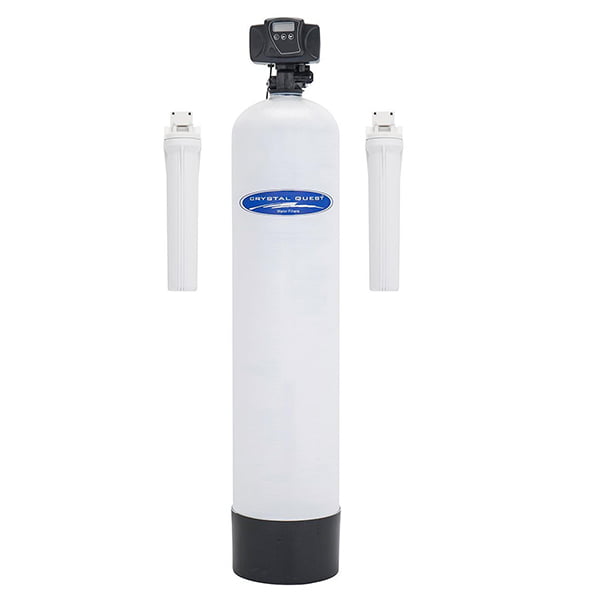 Best Whole House System: Crystal Quest |
Overall Rating: 4.5/5.0 ⓘRatings based on fluoride and chlorine removal %, price, annual maintenance cost, filter capacity, NSF testing/certification, warranty, customer service, user feedback, direct testing, and other factors.
Get 5% Off! Use Code: |
Price: $$$ Type: Whole House Filter Fluoride Reduction: 90-95% Chlorine Reduction: Up to 99% NSF: – Read Review: Click |
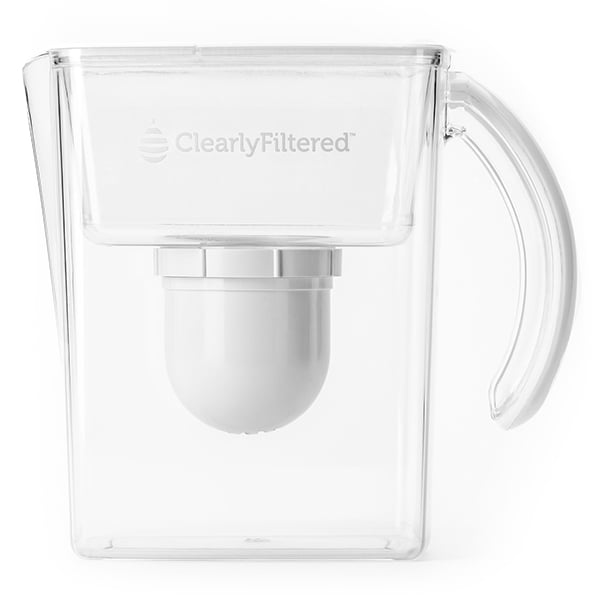 Best for Ease of Use: Clearly Filtered Pitcher |
Overall Rating: 5.0/5.0 ⓘRatings based on fluoride and chlorine removal %, price, annual maintenance cost, filter capacity, NSF testing/certification, warranty, customer service, user feedback, direct testing, and other factors.
Get 10% Off! Use Code: |
Price: $ Type: Filter Pitcher Fluoride Reduction: 99.5% Chlorine Reduction: 99.5% NSF: 42, 53, 401, P473 Read Review: Click Alexa’s Video Review: Click |
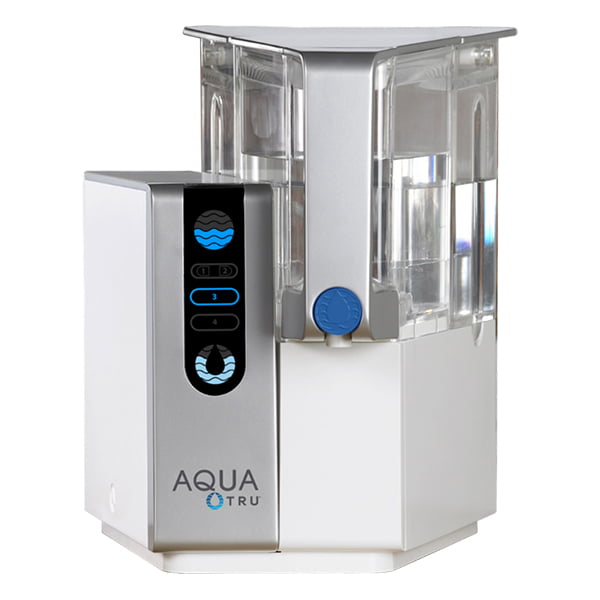 Best for RO Purification: AquaTru |
Overall Rating: 4.5/5.0 ⓘRatings based on fluoride and chlorine removal %, price, annual maintenance cost, filter capacity, NSF testing/certification, warranty, customer service, user feedback, direct testing, and other factors.
Get 15% Off! |
Price: $$ Type: Reverse Osmosis Fluoride Reduction: 93.5% Chlorine Reduction: 96.6% NSF: 42, 53, 58, 401, P473 Read Review: Click Alexa’s Video Review: Click Sara’s Video Review: Click |
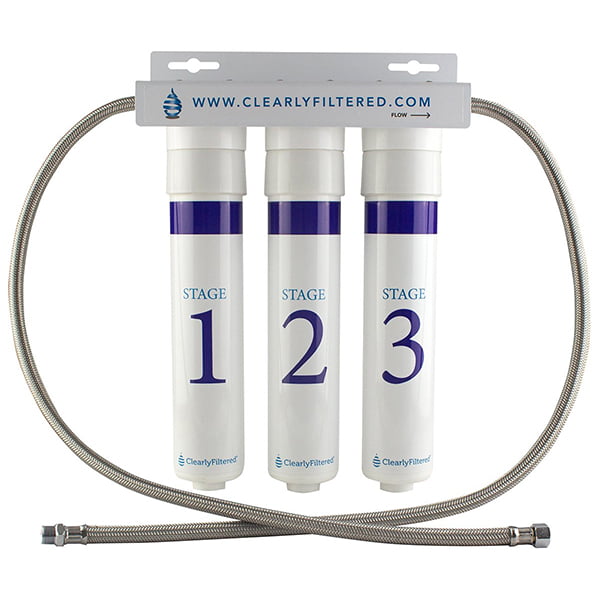 Best for Under the Sink: CF 3-Stage System |
Overall Rating: 5.0/5.0 ⓘRatings based on fluoride and chlorine removal %, price, annual maintenance cost, filter capacity, NSF testing/certification, warranty, customer service, user feedback, direct testing, and other factors.
Get 10% Off! Use Code: |
Price: $$ Type: Under Sink Filter Fluoride Reduction: 90.7% Chlorine Reduction: 98.6% NSF: 42, 53, 401 Read Review: Click Alexa’s Video Review: Click |
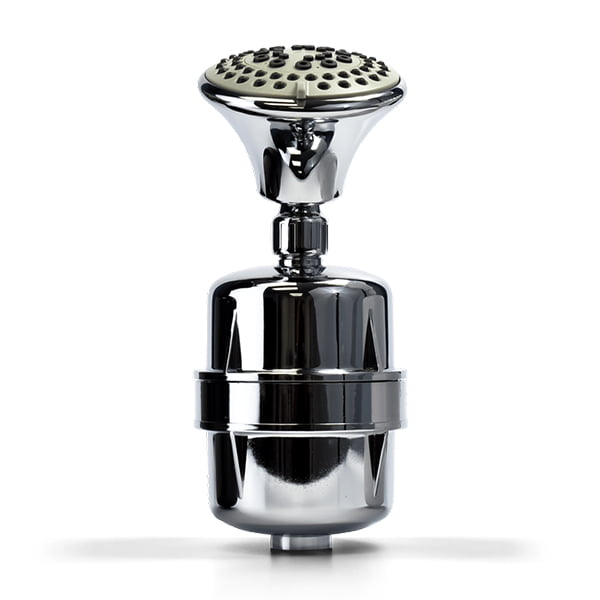 Best for Showering: ProOne ProMax |
Overall Rating: 4.0/5.0 ⓘRatings based on fluoride and chlorine removal %, price, annual maintenance cost, filter capacity, NSF testing/certification, warranty, customer service, user feedback, direct testing, and other factors.
|
Price: $ Type: Shower Filter Fluoride Reduction: 48.2% Chlorine Reduction: 57.1% NSF: 42, 53, P231, P473 Read Review: Click |
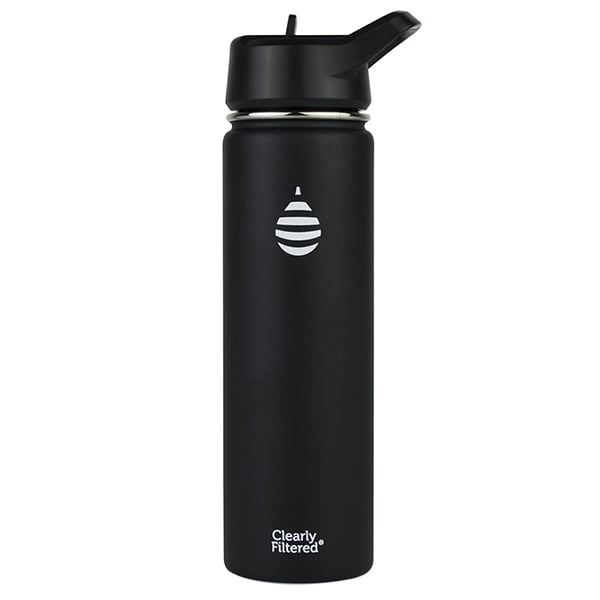 Best Fluoride/Chlorine Filter Bottle: Clearly Filtered |
Overall Rating: 5.0/5.0 ⓘRatings based on fluoride and chlorine removal %, price, annual maintenance cost, filter capacity, NSF testing/certification, warranty, customer service, user feedback, direct testing, and other factors.
Get 10% Off! Use Code: |
Price: $ Type: Filter Bottle Fluoride Reduction: 99.5% Chlorine Reduction: 99.5% NSF: 42, 53, 401 Read Review: Click Alexa’s Video Review: Click |
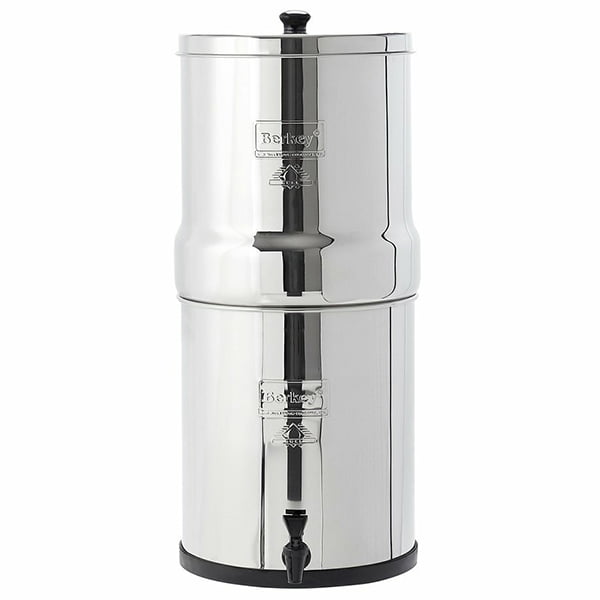 Ideal for Home + Outdoors: Big Berkey |
Overall Rating: 4.5/5.0 ⓘRatings based on fluoride and chlorine removal %, price, annual maintenance cost, filter capacity, NSF testing/certification, warranty, customer service, user feedback, direct testing, and other factors.
|
Price: $$ Type: Gravity Filter Fluoride Reduction: 97% Chlorine Reduction: 99.9% NSF: 42, 53 Read Review: Click |
 Best for Inline & Refrigerators: CF Universal |
Overall Rating: 5.0/5.0 ⓘRatings based on fluoride and chlorine removal %, price, annual maintenance cost, filter capacity, NSF testing/certification, warranty, customer service, user feedback, direct testing, and other factors.
Get 10% Off! Use Code: |
Price: $ Type: Inline & Fridge Filter Fluoride Reduction: 90.7% Chlorine Reduction: 98.6% NSF: 42, 53, 401 Read Review: Click |
Fluoride and Chlorine Water Filter Reviews
Our Top Picks
- Crystal Quest – Best for Whole House Fluoride + Chlorine Filtration
- USWS Bodyguard Combo – Whole House Runner-Up
- Clearly Filtered Pitcher – Best for Ease of Use
- AquaTru – Best for RO Water Purification
- Clearly Filtered 3-Stage – Best for Under Your Sink
- ProOne ProMax – Best for Showers
- Clearly Filtered Bottle – Best for On the Go Filtration
- Big Berkey – Best for Gravity Filtration
- Clearly Filtered Universal – Best for Inline Use and Refrigerators
- Megahome – Best for Distilled Water
1. Best for Whole House: Crystal Quest Fluoride and Chlorine Water Filter
For whole house use, the Crystal Quest is the best water filter to remove fluoride and chlorine in 2024. When used properly, fluoride content can be reduced to up to 90-95%, and chlorine up to 99%!
This water filter is available in two sizes; the smaller of which suits homes that contain up to 3 bathrooms, and the bigger system suits homes for 4 or more baths.
Each size comes equipped with a head valve, which is programmable and provides automatic backwashing which lets the fluoride filter media increase its life to up to 1 million gallons of filtered water! This means you won’t need to replace the filter media for several years each time.
Gallery
Other Specs
- Model: CQE-WH-11630, CQE-WH-11640
- Last Price: $1,665.00-$2,083.00
- Annual Maintenance Cost: ~$115-140
- Primary Filter Media: Bone Char + Carbon
- Filter Stages: 3
- Flow Rate: 9-13 gpm
- Filtering Capacity: 750,000-1,000,000 gal
- WxHxD: 10-12″x52-54″x10-12″
- Water Temperature: 35-100 °F
- Water Pressure: 20-60 psi
- Fitting: ¾”-1″
- Warranty: 1 Year
Key Features & Pros
- Large particles such as dirt, silt and sand are prevented from sticking in the tank thanks to the 5-micron sediment pre-filter (20”) that traps them.
- Makes use of a charcoal based mineral tank that contains granular activated fluoride filter media. Maximum fluoride removal is ensured by the combination of chemical reactions and absorption.
- Mercury, arsenic, and lead are also removed.
- The whole house filter is specifically designed to be effective with municipal water that contains inorganic fluoride.
- Works with many different pH levels.
- Bacteria are prevented from growing inside the tank thanks to copper-zinc alloy.
- Taste of the drinking water is further improved by the 5-micron coconut-shell carbon block post-filter (20”) which eliminates pollutants and chemicals like chlorine.
- Two sizes to choose from:
- The smaller model has filter media of 1.5 cubic feet, and at a flow rate of 9-11 gallons per minute it will last for 750,000 gallons.
- The larger model has filter media of 2.0 cubic feet, and its 10-13 gpm flow rate allows it to last for as much as 1,000,000 gallons!
- Easy installation and programming thanks to solid instructions.
- There’s a choice between steel or fiberglass casing to provide durability.
- Life of sediment pre-filter is 2 years, while the carbon post-filter has a life of 12-18 months. The system should work for an estimated 8-10 years before bone char requires replacement (if used by a family of four).
- Overall average cost annually: $115-140, with the larger system obviously costing more.
- Warranty of one year covered by the manufacturer.
Cons
- Quite a steep price tag at the beginning.
Our Rating
- Filtration Performance: 4.5/5.0
- Filter Capacity (Life): 5.0/5.0
- Purchase Price: 4.0/5.0
- Annual Cost: 5.0/5.0
- Overall: 4.5/5.0
Best for
The Crystal Quest is best for people who want a highly effective POE filter system for removing chlorine and fluoride.
2. Whole House Water Filter System Alternative: USWS Bodyguard + Fluoride Combo
If you want a solid alternative to the Crystal Quest, then this whole house filter combo by US Water Systems is the way to go. It entails the Bodyguard Whole House Chemical Removal Filter plus the Fluoride Removal Filter.
The combo can remove chlorine by up to 99% and fluoride up to 98%, as well as other harmful water contaminants such as chloramine, lead, and chemicals like pesticides.
The Bodyguard has a robust 5-step filtration process, most importantly a 5-micron sediment pre-filter cartridge followed by KDF-55, coconut shell granular activated carbon, and catalytic carbon filter media. The fluoride filter is based on bone char.
All in all, you get clean, fluoride-free, and great-tasting water everywhere around your home. This not only protects your plumbing and appliances, it also benefits your hair and skin – think chemical-free showers.
Other Specs
- Model: 117-BGS
- Last Price: $1,896.36-$2,796.36
- Annual Maintenance Cost: ~$50-90
- Primary Filter Media: Bone Char + Carbon
- Filter Stages: 3
- Flow Rate: 10-20 gpm
- Filtering Capacity: 400,000-1,000,000 gal
- WxHxD: 9-12″x52.5-58.5″x9-12″
- Water Temperature: 40-100 °F
- Water Pressure: 20-90 psi
- Fitting: ¾”-1″
- Warranty: 3 Years to Lifetime
Key Features & Pros
- Improves the taste and smell of water thanks to Bodyguard’s 5-step filtration process:
- Step 1: 5-micron Magna pre-filter is made in the US, and traps large particles, so they don’t stick in the tank.
- Step 2: Washed quartz gravel provides a great substrate for even upflow filtration.
- Step 3: KDF-55 redox filter media is bacteriostatic, preventing the growth of bacteria and removing chlorine by up to 80%.
- Step 4: Coconut shell granular activated carbon further removes chlorine and other chemicals.
- Step 5: Catalytic carbon focuses on removing chloramine.
- Fluoride filter uses bone char + quartz gravel. This provides for most effective fluoride filtration at the point of entry.
- Both tanks use Vortech technology which prolongs contact time between water and filter media for improved contaminant reduction rates.
- Three sizes to choose from:
- The BGS-10-FL has a continuous flow rate of 8 gpm (gallons per minute), and a maximum flow rate of 10 gpm. Ideal for up to 3 bathrooms.
- The BGS-15-FL provides up to 15 gpm suited for 4-5 baths.
- The BGS-20-FL is rated at a continuous water flow of 16 gpm, and a maximum flow rate of 20 gpm. It’s designed for very large homes with 6+ bathrooms.
- Straightforward installation process with easy-to-follow instructions.
- Bypass valve included.
- One pre-filter cartridge lasts 6-12 months (~$50-90 annual replacement cost). The filter media contained in the Bodyguard tank lasts a full 1,000,000 gallons or 5 years. The fluoride removal media is good for 400,000 gallons or 3 years.
- Low maintenance!
- You get lifetime warranties on the tanks + heads. The filter media is warranted for 3-5 years.
Cons
- The whole house combo is rather pricey.
- The media doesn’t come pre-installed, and improper installation can lead to filtration issues.
- USWS states filter media needs to be changed every 3-5 years, which is shorter than the 8 years of the Crystal Quest and other similar systems.
Our Rating
- Filtration Performance: 5.0/5.0
- Filter Capacity (Life): 4.0/5.0
- Purchase Price: 4.0/5.0
- Annual Cost: 5.0/5.0
- Overall: 4.5/5.0
Best for
The USWS Bodyguard combo is our second top pick for removing chlorine and fluoride from water at the point of entry.
3. Best for Ease of Use: Clearly Filtered Pitcher
For point-of-use applications, the Clearly Filtered pitcher is far and away the best water filter for chlorine and fluoride in 2024. This is mainly because it eliminates more waterborne pollutants than all other water pitcher filters! If clean, pure drinking water is a priority for you, then so should the Clearly Filtered!
With a reduction in both fluoride and chlorine of at least 99.5%, it’s a bargain for what you pay.

Clearly Filtered Water Pitcher |
|
| Price: | $ |
| Type: | Pitcher |
| Fluoride Removal: | 99.5% |
| Chlorine Removal: | 99.5% |
| NSF/ANSI: | 42, 53, 401, P473 |
|
Overall Rating: 5.0/5.0 ⓘRatings based on fluoride and chlorine removal %, price, annual maintenance cost, filter capacity, NSF testing/certification, warranty, customer service, user feedback, direct testing, and other factors.
Get 10% Off! Use Code: |
|
Alexa’s Video Review
Alexa, our inhouse video content producer, has ordered and tested the Clearly Filtered Water Pitcher with her own hands. In other words, she has assembled and used the pitcher at home for several weeks to gain invaluable first-hand experience and insights. Alexa has documented the entire process and shares her opinion in the video below:
Other Specs
- Model: CF-PRF
- Last Price: $90
- Annual Maintenance Cost: ~$150
- Filter Media: Carbon + Composite Shell
- Storage Capacity: 80 oz (10 Cups)
- Filter Life: 100 gal
- WxHxD: 11.25″x10.25″x5″
- Weight (Empty): 2.3 lb
- Warranty: Lifetime (Limited)
Key Features & Pros
- This water pitcher filter is tested against a total of four NSF standards (42, 53, 401, and P473) to excellent results. Over 365 contaminants are targeted, including chlorine and fluoride, chloramine (99.7%), arsenic (98.3%), lead (99.3%), over 20 pharmaceuticals (up to 99.9%), PFAS (up to 99.5%), over 100 VOCs (most to 99.9%), many herbicides (up to 99.9%), chromium-6 (97.8%) and pesticides (up to 99.8%).
- However, all healthy, beneficial minerals remain in your water supply! These can add to regular daily intake.
- It makes use of Affinity Filtration Technology, which combines granular activated carbon with other important filtering material.
- The pitcher filter only takes about 2 minutes to assemble – putting it together is simple (and we can attest to this!)
- Has the capacity to hold 10 glasses of filtered water maximum. If refilled regularly, this is plenty for an entire family.
- Both the filters and the pitcher itself are completely free of BPA thanks to being made of Tritan plastic, which also does not leach chemicals. They are also produced in the US!
- A filter cartridge lasts for about 100 gallons of filtered water, which on average works out to about 4 months and helps to keep all maintenance to the absolute minimum. They do cost $50 per cartridge, but it’ll be cheaper and cost effective if you subscribe and purchase in bulk!
- A 30-day refund guarantee ensures you’ll get your money back in full if you are not happy!
- Top grade customer support and a limited lifetime warranty on the pitcher are the icing on the cake.
Cons
- Clearly Filtered’s water pitcher filter is not only more expensive, but also more difficult to maintain than other pitcher filters.
- While we haven’t had any problems ourselves, some customers report that their filter pitchers don’t have as long a life as they are advertised to have, as well as slow filtration speed.
- Slower filtration speed can actually be a good thing, as a longer contact period between filter media and water allows for more in depth filtering.
- Clearly Filtered will also replace unsatisfactory water filters for free.
Our Rating
- Filtration Performance: 5.0/5.0
- Filter Capacity (Life): 5.0/5.0
- Purchase Price: 4.0/5.0
- Annual Cost: 4.5/5.0
- Overall: 5.0/5.0
Best for
The Clearly Filtered pitcher is best for people who want to remove fluoride and chlorine from their drinking water.
→ Check Full CF Pitcher Review
4. Best for RO Water Purification: AquaTru Countertop System
Even the smallest of POU RO systems are highly effective at fluoride removal in tap water supplies. For one, the AquaTru is certified to remove over 93% of fluoride! This plus the 96.6% removal of chlorine is the system’s biggest selling point.
In fact, it’s our opinion that the AquaTru is the best performing reverse osmosis fluoride + chlorine filtration system on the market. It’s NSF-certified (standards 53, 58, 42 and 401 and protocol P473) which guarantees dozens of pollutants will be eradicated from your water supply.
What’s more, the AquaTru system doesn’t even need to be permanently installed. As long as it’s placed on a countertop and plugged into a power supply, it’s ready to go! This convenient feature makes it ideal for those who rent, or who are even just visiting a home with no water filter. Maintenance of this system is also simple as can be, and with an affordable price, the AquaTru RO system basically sells itself.

AquaTru Countertop Reverse Osmosis System |
|
| Price: | $$ |
| Type: | Reverse Osmosis |
| Fluoride Removal: | 93.5% |
| Chlorine Removal: | 96.6% |
| NSF/ANSI: | 42, 53, 58, 401, P473 |
|
Overall Rating: 4.5/5.0 ⓘRatings based on fluoride and chlorine removal %, price, annual maintenance cost, filter capacity, NSF testing/certification, warranty, customer service, user feedback, direct testing, and other factors.
Get 15% Off! |
|
Alexa’s Video Review
Alexa, our inhouse video content producer, has ordered and tested the AquaTru Reverse Osmosis System. In other words, she set up the AquaTru with her own hands and used it in her home for several weeks to gain invaluable first-hand experience and insights. Alexa has documented the entire process and shares her opinion on the water filter in the video below:
Sara’s Video Review
Sara has also tested the AquaTru. And here review even includes lab testing, so a comparison of the unfiltered vs. filtered water:
Other Specs
- Model: AquaTru
- Last Price: $449.00
- Annual Maintenance Cost: ~$100-120
- Primary Filter Media: Carbon, RO
- Filter Stages: 4
- Water: 1 Gallon in 10-15 min
- Recovery Rate: 80%
- Filter Life: 600-1200 Gallons
- WxHxD: 12″x14″x14″
- Water Temperature: 39-100 °F
- Operating Pressure: 40-85 psi
- Warranty: 1 Year
Key Features & Pros
- AquaTru RO countertop filter system is NSF certified. Its 5 certifications ensure that your water is fresh, clean, and ready for cooking and drinking! Over 80 pollutants are eliminated, including chlorine (96.6%), fluoride (93.5%), PFAS (97.5%), chromium-6 (97.2%), lead (99.1%), pharmaceutical drugs, pesticides, VOCs, and cysts (99.99%).
- A filtration system of 4 stages guarantees this:
- Stages 1 & 2 involve a mixture of activated carbon filtering and a sediment pre filter. This will filter out chemicals and large particles that would otherwise cause the system to clog.
- In Stage 3, the RO membrane then removes the contaminating elements in the list above, and also more pollutants.
- Stage four utilizes carbon filtration for even more chemical removal and better water taste.
- 1 gallon of purified water is produced every ten to fifteen minutes due to the speedy filtration of the water pump that is built in!
- Wastewater is also reduced thanks to high water pressure. About 80% of water is recovered, and 20% of all input water makes its way down your drain. (RO water filter systems that do not make use of pumps will waste up to three to five gallons of water to every gallon that is filtered!)
- No plumbing or drilling is required when setting up the system. It takes ten minutes tops.
- Its design saves space.
- Simple to operate! The tank is filled with water and then installed back into the system. The reverse osmosis water gathers in the storage tank at the front, while the rejected water will be collected in the second tank, whereafter it can easily be disposed of.
- Dispensing is carried out by a button that is easy to push.
- The system’s plastic is free from BPS and BPA.
- The filters have a life anywhere between six months and two years. Replacement can be conducted annually or bi-annually and can be conducted tool-free, and only takes several minutes! You’ll be reminded to install new filters via front panel lights.
- The estimated cost is $100 – $120 annually, which is affordable for the system you get.
- There is a one year manufacturer warranty.
Cons
- A small number of customers had leak problems. Some even claimed that their RO system ceased working altogether.
Our Rating
- Filtration Performance: 4.5/5.0
- Filter Capacity (Life): 5.0/5.0
- Purchase Price: 4.0/5.0
- Annual Cost: 5.0/5.0
- Overall: 4.5/5.0
Best for
The AquaTru is best for people looking for an RO system. It’s installation-free, compact, highly effective, and fast.
→ Read: AquaTru Water Filter Review
5. Best for Under Your Sink: Clearly Filtered 3-Stage
This Clearly Filtered unit is our number one fluoride filtration under sink system on the market in 2024. As well as the removal of 90.7% fluoride, it also provides the elimination of 98.6% of chlorine and over 230 other contaminants! This has been guaranteed by EPA-approved labs and testing that met important NSF standards.
To summarize, no other under sink system will do a better job at filtering fluoride, chlorine and general contamination from your water than the Clearly Filtered 3-Stage.

Clearly Filtered 3-Stage Under Sink Water Filter |
|
| Price: | $$ |
| Type: | Under Sink Filter |
| Fluoride Removal: | 90.7% |
| Chlorine Removal: | 98.6% |
| NSF/ANSI: | 42, 53, 401 |
|
Overall Rating: 5.0/5.0 ⓘRatings based on fluoride and chlorine removal %, price, annual maintenance cost, filter capacity, NSF testing/certification, warranty, customer service, user feedback, direct testing, and other factors.
Get 10% Off! Use Code: |
|
Alexa’s Video Review
As part of the BOS team, Alexa has installed and tested the Clearly Filtered Under-the-Sink Water Filter System in her own home and with her own hands. She has used the system for several weeks to gather genuine first-hand experience. And most importantly, Alexa has documented the entire process, including her findings and personal opinion, in the video below:
Other Specs
- Model: 3-Stage Under the Sink Water Filter System
- Last Price: $550
- Annual Maintenance Cost: ~$440
- Filter Media: Carbon + Proprietary Blend
- Filter Stages: 3
- Filter Life: 2,000 Gallons
- WxHxD: 15″x15.4″x3.1″
- Fitting: ⅜”
- Warranty: Lifetime (Limited)
Key Features & Pros
- Produced in the USA.
- System is tested against NSF standards 42, 53 & 401. It traps and filters out lead (99.9%), chlorine (98.6%), chloramine (95.3%), hexavalent chromium (99.4%), PFA (99.9%), arsenic (94.3%), SVOCs (99.9%) & over 100 volatile organic compounds and other pollutants.
- It does all this while retaining all beneficial and healthy minerals.
- 3 filtering stages: Stage 1 involves coconut shell GAC. Stages 2 & 3 are a blend of proprietary media (a.k.a. Affinity Filtration Technology).
- Installation is DIY, takes 15 minutes maximum and doesn’t need to be permanent, which is ideal for people renting and anyone looking to save some money!
- All necessary hardware will be included.
- On average, filters have a life of 365 days and are easily replaced in a matter of seconds. No tools are required, neither is the need for shutting off your water supply.
- Hoses are stainless steel and are utilized for durability.
- A limited lifetime guarantee is provided for the entire system.
- There’s a thirty-day money back guarantee to receive a refund, if you aren’t satisfied with the product!
Cons
- Water pressure is reduced by around 25-35% by the filtration system.
- It’s a bit more expensive than other water filters, as are its replacement filters.
- However, for the performance you get and the longevity of the filters, we believe it’s worth it.
- When you subscribe, you’ll receive filters on a regular basis whilst saving 10% overall, as well as free shipping.
Our Rating
- Filtration Performance: 5.0/5.0
- Filter Capacity (Life): 5.0/5.0
- Purchase Price: 4.0/5.0
- Annual Cost: 4.5/5.0
- Overall: 5.0/5.0
Best for
The Clearly Filtered 3-Stage is best if you prefer an under sink water filter. The system is highly effective at removing both chlorine and fluoride.
→ Read: Clearly Filtered Under-the-Sink Filter Review
6. Best for Showering: ProOne ProMax Shower Filter
Unfortunately, there does not yet exist a type of shower head that can effectively filter out and remove both chlorine and fluoride – some companies believe they have shower filters that reduce fluoride and chlorine, but they haven’t been found to be effective.
The next best thing that we found would be the ProOne ProMax Shower Filter. With a chlorine reduction rate of 57.1% and fluoride reduction rate of 48.2%, this is the shower filter we recommend you use if you want to reduce these elements in your shower water.
Side note: If it’s within your budget, nothing is better than whole house filter systems to remove fluoride and chlorine from your water. Point-of-entry models treat all water in your home supply, including shower water. This leads to more thorough water filtration, such as the Crystal Quest filter, which can remove up to 90-95% of fluoride.
However, if you’re interested in ProOne ProMax, its specifications are as follows:

ProOne ProMax Shower Filter |
|
| Price: | $ |
| Type: | Shower Water Filter |
| Fluoride Removal: | 48.2% |
| Chlorine Removal: | 57.1% |
| NSF/ANSI: | 42, 53, P231, P473 |
|
Overall Rating: 4.0/5.0 ⓘRatings based on fluoride and chlorine removal %, price, annual maintenance cost, filter capacity, NSF testing/certification, warranty, customer service, user feedback, direct testing, and other factors.
|
|
Other Specs
- Model: PM-9000CHR
- Annual Maintenance Cost: ~$85
- Primary Filter Media: Proprietary
- Flow Rate: 2 gpm
- Filter Life: 6 Months
- WxHxD: 3.5″x9″x3.5″
- Ideal Water Temperature: 100 °F
- Ideal Water Pressure: 80 psi
- Fitting: ½” NPT
- Warranty: 1 Year
Key Features & Pros
- Utilizes four proprietary filter layers.
- NSF tested (standards 42, 53 & protocols P231 & P473) to remove over 200 contaminating elements in your water, thus saving you from any detrimental health issues. The most reliable testing we have witnessed being carried out via a shower filter head.
- Chloramine (71.0%), chlorine (57.1%), VOCs (around 90%), fluoride (48.2%), mercury (79.2%), lead (61.1%), arsenic (28.0%), pesticides (50 – 60%), chromium (28.8%), semi-volatile compounds (70 to 80%), nitrates (23.6%). nitrites (82.8%).
- While the results aren’t outstanding, they are better than other shower head filters.
- Flow rate of 2 gpm allows for adequate pressure.
- Includes a massaging head feature with five settings for spray.
- A choice of three finishes: Brushed nickel, antique bronze or chrome.
- Chrome and brushed nickel finishes also include a wand that is handheld.
- Maintenance and installation is simple and won’t take up a lot of time.
- Fits regular half pipe threads.
- Each filter will last for six months. Each cartridge costs $42.
- Plastic is free from BPA.
- A year limited warranty and a 30-day guarantee.
Cons
- Can be quite expensive considering the less than perfect results.
Our Rating
- Filtration Performance: 4.0/5.0
- Filter Capacity (Life): 5.0/5.0
- Purchase Price: 3.5/5.0
- Annual Cost: 4.5/5.0
- Overall: 4.0/5.0
Best for
The ProOne ProMax is best if you want access to filtered shower water at an affordable price.
→ Read Our Full ProOne ProMax Review Here
7. Best for On the Go: Clearly Filtered Bottle
The best fluoride and chlorine filter bottle (according to us) is another product from Clearly Filtered. There is a choice of 3 models; a stainless steel insulated filtered bottle, a Tritan plastic filter bottle, and a bottle constructed from glass.
While the materials differ, each bottle uses identical filter cartridges to remove practically the same number of contaminants that the CF water pitcher removes (which is reviewed above). Therefore, we can say with certainty that the water filtration is thorough and in-depth, more so than any other filter bottle we are aware of. With a fluoride and chlorine reduction rate of 99.5%, it’s easy to see why many customers are satisfied with their purchase.

Clearly Filtered Insulated Stainless Steel Water Bottle |
|
| Price: | $ |
| Type: | Filter Bottle |
| Fluoride Removal: | 99.5% |
| Chlorine Removal: | 99.5% |
| NSF/ANSI: | 42, 53, 401 |
|
Overall Rating: 5.0/5.0 ⓘRatings based on fluoride and chlorine removal %, price, annual maintenance cost, filter capacity, NSF testing/certification, warranty, customer service, user feedback, direct testing, and other factors.
Get 10% Off! Use Code: |
|
Alexa’s Video Review
Being an integral member of our team, Alexa has tested 2 Clearly Filtered Water Bottles for us. Which means Alexa has ordered, primed, and used both bottles in her day-to-day life for several weeks to gain some first-hand experience. She shares her findings and personal verdict in the video below:
Other Specs
- Model: Insulated Stainless Steel Filtered Water Bottle
- Last Price: $65
- Annual Maintenance Cost: ~$50
- Filter Media: Proprietary Blend
- Storage Capacity: 20 oz
- Filter Life: 25 gal
- WxHxD: 3″x3″x11″
- Weight (Empty): 0.8 lb
- Warranty: Lifetime
Key Features & Pros
- Safe, healthy and fresh tasting water.
- The quality is very high.
- Affinity filtration by Clearly Filtered will filter out over 220 water contaminants. 99.5% fluoride and chlorine, 99.9% lead, 99.9% pharmaceuticals, 99.9% herbicides, 99.9% VOCs, semi-volatile compounds and pesticides.
- Tested by EPA-accredited laboratories for NSF standards 42, 53, & 401.
- Straightforward use. Fill the bottle, then suck the water out via the mouthpiece attached to its filter straw. The steel bottle has double-wall insulation, allowing for a maximum of 24 hours cooling.
- Each filter lasts for 6 months or 25 filtered gallons.
- This equates to 160 refills for the glass and steel filtered bottles, and the plastic just over 130 refills.
- A choice of a range of colors!
- Every material is free from BPS, BPA and phthalate, meaning nothing seeps into your drinking water.
- Constructed in the USA.
- 30-day refund guarantee as well as lifetime warranty coverage!
Cons
- Strong suction is required to get adequate water (think drinking thick milkshakes).
- The filters will end up less restrictive.
- The bottle can leak if its silicone lid ring isn’t in the correct position.
Our Rating
- Filtration Performance: 5.0/5.0
- Filter Capacity (Life): 4.5/5.0
- Purchase Price: 4.0/5.0
- Annual Cost: 5.0/5.0
- Overall: 5.0/5.0
Best for
The Clearly Filtered water filter bottle is best if you want clean water while you are outside the house.
8. Best for Home & Outdoor Use: Big Berkey Gravity Water Filter
Berkey water systems are effective gravity filters. As countertop units designed to be portable, they’re straightforward to install, simple to use, almost maintenance free, and highly effective at taking out a plethora of contaminating elements to allow for high-quality drinking water. 99.9% of fluoride and chlorine are removed when used in conjunction with the PF-2 fluoride filter.
It’s worth noting there are no differences between various Berkey filters other than their size, on which water capacity and filtration speed are determined. Outside of this, they use the same filtration elements which allow them to achieve equal water purity levels. The Big Berkey system is our favorite; it’s ideal for smaller families (around four people) and also isn’t very bulky, so it fits in the majority of kitchens and doesn’t take up too much space.

Big Berkey Gravity Water Filter |
|
| Price: | $$ |
| Type: | Gravity Filtration System |
| Fluoride Removal: | 97% |
| Chlorine Removal: | 99.9% |
| NSF/ANSI: | 42, 53 |
|
Overall Rating: 4.5/5.0 ⓘRatings based on fluoride and chlorine removal %, price, annual maintenance cost, filter capacity, NSF testing/certification, warranty, customer service, user feedback, direct testing, and other factors.
|
|
Other Specs
- Model: Big Berkey (with PF-2 Filters)
- Last Price: $481.64
- Annual Maintenance Cost: ~$155
- Primary Filter Media: Carbon + Ion Exchange + Activated Alumina
- Flow Rate: Up to 7 gph
- Storage Capacity: ~2.25 Gallons
- Filter Life: 3,000 gal
- PF-2 Filter Life: 500 gal
- WxHxD: 8.5″x21″x8.5″
- Warranty: 2 Years to Lifetime
Key Features & Pros
- Produces fresh-tasting water.
- Accredited laboratories have tested and certified that Berkey filters remove fluoride, chlorine, chloramine, bacteria, cysts, viruses, lead and other heavy metals, THMs, VOCs, Ibuprofen, pesticides, Bisphenol A, sediment, tastes and smells, and many more contaminants. NSF standards: 42 & 53.
- Healthy minerals are retained in the drinking water.
- Optional and additional PF-2 filters for improved fluoride reduction. (Fluoride reduction is effective to a maximum of 500 gallons.)
- The filters use gravity to work. No external pressure or power is required. This makes them useful for emergency use or power cuts.
- Practically all water can be used as the feed source.
- Filter cartridges last a long time, making them cost effective.
- Food-grade 304 steel tanks, meaning they have durability and also look quite good!
- The casket is made of rubber and will protect your countertop from any scratches.
- Ten minutes maximum to assemble.
Cons
- Fluoride replacement filters have a significant cost.
- There is a risk of overfilling, as if the lower tank is filled up, filtration doesn’t stop.
- The upper chamber has to be lifted in order to check the amount of filtered water that remains.
- Plastic spigot leaked for some customers.
- Frequent re-priming of the filter is required.
- Negative pressure may cause the flow from the spigot to be slow.
Our Rating
- Filtration Performance: 4.5/5.0
- Filter Capacity (Life): 4.5/5.0
- Purchase Price: 4.0/5.0
- Annual Cost: 4.5/5.0
- Overall: 4.5/5.0
Best for
The Big Berkey is best for home and outdoor use. It’s one of the most effective at removing chlorine as well as fluoride.
→ Click for Full Big Berkey Review
9. Best for Inline & Refrigerators: CF Universal
The best fridge/inline water filter that removes chlorine and fluoride in 2024 would be the Clearly Filtered Universal, mainly because it’s the one and only inline unit properly tested to remove fluoride. The result is an effective filtration process that removes an average of 90.7% of fluoride and 98.6% chlorine.
Also helpful: The CF Universal is an inline filter, meaning it’s compatible with every appliance, including refrigerators. Once installed, any filter that came with your refrigerator doesn’t need to be used anymore. This can possibly be taken out, depending on the model.

Clearly Filtered Universal Inline and Refrigerator Water Filter |
|
| Price: | $ |
| Type: | Inline & Fridge Filter |
| Fluoride Removal: | 90.7% |
| Chlorine Removal: | 98.6% |
| NSF/ANSI: | 42, 53, 401 |
|
Overall Rating: 5.0/5.0 ⓘRatings based on fluoride and chlorine removal %, price, annual maintenance cost, filter capacity, NSF testing/certification, warranty, customer service, user feedback, direct testing, and other factors.
Get 10% Off! Use Code: |
|
Other Specs
- Model: Universal Inline Fridge Filter
- Last Price: $165
- Annual Maintenance Cost: $165
- Filter Media: Carbon + Proprietary Blend
- Filtering Capacity: 365 gal
- WxHxD: 12″x2″x2″
- Warranty: Lifetime
Key Features & Pros
- The 2×12 inch design is slim and sleek – it can fit in tight corners of refrigerators.
- Assuming a quarter-inch water line is present, it will work with any model.
- Only needs several minutes to install. The existing line is just connected to the filter’s inlet and outlet.
- A braided steel line comes with it.
- A mounting bracket and screw are included.
- Over 232 tap water pollutants are removed thanks to the Affinity Filtration Technology, which is proven to meet NSF standards 53, 42, & 401.
- Unpleasant tastes and smells are absorbed by the filter media, including chloramine (95.3%), organic compounds, pesticides (99.9%), and herbicides (99.9%).
- A proprietary filtration media reduces micro-plastics, radiation, pharmaceuticals (almost all reduced by 99.9%), arsenic (94.3%), perfluorinated chemicals (99.9%), chromium (99.4%), cadmium (99.9%), aluminum (99.9%), VOCs + VOCs (99.9%), lead (99.9%) & mercury (99.9%).
- The filters don’t need to be replaced very often, as the system has a filtration capacity of 365 gallons.
- Produced in the USA.
- A lifetime warranty and a 30-day money back guarantee.
Cons
- At a price of $150, it’s more expensive than its competitors.
Our Rating
- Filtration Performance: 5.0/5.0
- Filter Capacity (Life): 5.0/5.0
- Purchase Price: 4.5/5.0
- Annual Cost: 4.5/5.0
- Overall: 5.0/5.0
Best for
The CF Universal is best for fluoride/chlorine removal at your refrigerator or inline.
10. Best for Water Distillation Removing Fluoride & Chlorine: Megahome
The Megahome distiller comes in a few different varieties, but inside they all work the same way. Potentially harmful substances like fluoride and chlorine are removed in the distillation process. Meanwhile, water always contacts either glass or stainless steel (304), which stops any plastic from contaminating your filtered water.
With many satisfied customers, it seems like the Megahome delivers pure drinking water, exactly as promised.
Other Specs
- Model: MH943S
- Water: 0.18 gph
- Storage Capacity: 1 gal
- WxHxD: 14.17″x9.25″x9.25″
- Power Source: 110-120 V
- Wattage: 580
- Warranty: 1 Year
Key Features & Pros
- A straightforward method of operation.
- One gallon of filtered water is delivered every 5 and a half hours – adequate amount for smaller families!
- It’s a cheaper option than purchasing bottled water all the time – each distillation cycle only costs an average of 35-50 cents on your electricity bill!
- The filtered water will be practically 100% pure.
- Volatile compounds, pollutants and bad odors and tastes will be absorbed by GAC filter sachets.
- A glass insert comes with the sachet housing.
- Replacements are also affordable.
- Only takes several minutes to assemble.
- Simple to clean.
- Safety standard compliant, as it is UL-listed & safety approved!
- BPA-free materials.
- You are able to buy any replacement parts online.
- 1 year warranty coverage.
Cons
- Sometimes residue can bake and stick on the boiling chambers after the distillation cycle.
- Tip: A timer switch can be set to turn this off prior to the water being evaporated.
- Start button needs to be pressed quite deeply to turn on the machine.
- Some customers report that for some reason, the distiller will turn itself off prematurely.
Our Rating
- Filtration Performance: 5.0/5.0
- Energy Consumption: 5.0/5.0
- Purchase Price: 4.0/5.0
- Overall: 5.0/5.0
Best for
The Megahome is best for people who want to eliminate fluoride and chlorine from their water using a distiller.
→ Reviewed: Megahome Distiller
Comparison List
(Mobile Hint: Swipe to Scroll)
| Model | Price | Annual Cost | Type | Fluoride Removal | Chlorine Removal | NSF/ANSI | Filter Media | Filter Life | Warranty | Additional Info |
|---|---|---|---|---|---|---|---|---|---|---|
| Crystal Quest Whole House Water Filter System | $$$ | ~$115-140 | Whole House Water Filter | 90-95% | Up to 99% | – | Bone Char + Carbon | 750,000-1,000,000 gal | 1 Year | |
| US Water Systems Bodyguard Whole House Combo | $$$ | ~$50-90 | Whole House Filter | Up to 98% | Up to 99% | – | Bone Char + Carbon | 400,000-1,000,000 gal | 3 Years to Lifetime | |
| Clearly Filtered Water Pitcher | $ | ~$150 | Pitcher | 99.5% | 99.5% | 42, 53, 401, P473 | Carbon + Composite Shell | 100 gal | Lifetime (Limited) | |
| AquaTru Countertop Reverse Osmosis System | $$ | ~$100-120 | Reverse Osmosis | 93.5% | 96.6% | 42, 53, 58, 401, P473 | Carbon, RO | 600-1200 Gallons | 1 Year | |
| Clearly Filtered 3-Stage Under Sink Water Filter | $$ | ~$440 | Under Sink Filter | 90.7% | 98.6% | 42, 53, 401 | Carbon + Proprietary Blend | 2,000 Gallons | Lifetime (Limited) | |
| ProOne ProMax Shower Filter | $ | ~$85 | Shower Water Filter | 48.2% | 57.1% | 42, 53, P231, P473 | Proprietary | 6 Months | 1 Year | |
| Clearly Filtered Insulated Stainless Steel Water Bottle | $ | ~$50 | Filter Bottle | 99.5% | 99.5% | 42, 53, 401 | Proprietary Blend | 25 gal | Lifetime | |
| Big Berkey Gravity Water Filter | $$ | ~$155 | Gravity Filtration System | 97% | 99.9% | 42, 53 | Carbon + Ion Exchange + Activated Alumina | 500-3,000 gal | 2 Years to Lifetime | |
| Clearly Filtered Universal Inline and Refrigerator Water Filter | $ | $165 | Inline & Fridge Filter | 90.7% | 98.6% | 42, 53, 401 | Carbon + Proprietary Blend | 365 gal | Lifetime | |
| Megahome Water Distiller | $ | $0 | Water Distiller | Up to 99% | Up to 99% | – | Unlimited | 1 Year |
Buying Guide: How to Choose the Fluoride and Chlorine Water Filter That’s Best for You
The following are key features worth considering when shopping for a fluoride and chlorine water filter. They will help you choose the right on for your needs and budget.
Testing Your Water Quality
First things first – you have to test your water supply before you buy and install a water filter! Only by testing your water will you know its specific conditions in regards to chlorine and fluoride levels, and whatever other criteria it may meet with the filter you intend to purchase.
Filter Types
Overall, there are three primary methods of water purification that are successful at removing both chlorine and fluoride. While most filtration systems remove chlorine, not all of them can remove fluoride effectively, so it’s important to keep these in mind when choosing a water filter to buy.
These methods are:
- Reverse osmosis
- Distillation
- Bone char
The filtration/purification method is more important than the kind of filter model (e.g. countertop or under sink) when it comes to removing chlorine and fluoride from your water supply.
With that said, specific types of filters are more effective than some regarding chlorine and fluoride filtration. These are:
- Whole house filters
- Water filter pitchers
- Under sink and countertop systems
- Water distillers
- Gravity units
- Filter bottles
NSF/ANSI Certifications
NSF & ANSI certifications guarantee that your chosen water filter will deliver exactly the results that it advertises.
An independent body called NSF International designates certain standards that products such as water filters will be tested against and held to.
NSF Standards 42 and 53 are usually signs that a filter can remove fluoride and chlorine. (NSF Standard 177 is also given for shower head filters effective in removing chlorine).
RO filter systems are also certified and tested against NSF Standard 58, which deals with fluoride reduction.
Flow Rate
Flow rate in regards to a water filter is simply the amount of filtered water that it can provide within a certain timeframe. This is particularly important for whole house filters.
Any water filter with very slow filtration can result in additional waiting periods or a decrease in water pressure.
Installation & Maintenance
Installing and maintaining water filters can differ, and is largely to do with the type of filter. For example, a whole house filtration system is more challenging to set up compared to an ordinary water pitcher filter.
Many filters don’t need to be installed (such as pitcher, gravity, bottle and countertop filters) making them cost effective and time saving!
Whole house and under sink water filters require sufficient installation. Sometimes this simply isn’t a DIY task and it’s worth spending the money on professional installation by a plumber.
Filtration Capacity & Cost
Filter capacity and overall cost go hand in hand. A filter with a long lifespan won’t require replacement very often, thus saving you a lot of time and money in the long term as you won’t constantly be buying and replacing new filters.
More on Water Filters for Chlorine and Fluoride
What Is Fluoride? What Is Chlorine?
Fluoride and chlorine are two naturally occurring elements that often have beneficial purposes in small quantities. For example, fluoride is added to some toothpaste to help strengthen teeth, and chlorine is added to swimming pools to keep the water clean. However, in large quantities, both can be very harmful to consume, especially in drinking water.
Water Fluoridation & Chlorination – How Chlorine and Fluoride Get Into Our Water Supply
In the US, fluoride is purposefully added to our water supply in hopes to strengthen teeth and reduce the risk of tooth decay. While this is effective in children, there’s less evidence of this working in adults.
Many countries in Europe have significantly declining cases of tooth decay as well and don’t add fluoride to their water, instead relying on toothpaste, which all suggests that fluoridating municipal water supplies might be unnecessary.
Chlorination of tap water in the US is for the purposes of disinfection, as it effectively kills bacteria, viruses and parasites that are leading causes of disease.
In this sense, chlorination can make drinking water much safer to consume. Since 1908, it’s been an effective method of removing waterborne pathogens like typhoid, which in turn saves countless lives and prevents grave sickness every year.
The CDC claims that chlorinating municipal water supplies was “one of the most significant public health advances in U.S. history” and that it increased life expectancy of the average American by an estimated 50% during the twentieth century.
Chlorination also removes bad smells and tastes!
Are There Health Risks Involved with Fluoride or Chlorine in Drinking Water?
As mentioned, both chlorine and fluoride are added to water supplies in order to remove harmful viruses, cysts and bacteria and also strengthen teeth. However, it can’t be denied that too much of these elements can lead to health issues.
Fluoride Consumption: Potential Health Effects
Once fluoride is introduced to water supplies, there isn’t a solid method of controlling the amount of fluoride each individual person will consume. This can be a bit alarming considering that most children have usually exceeded their daily fluoride intake through just nutrition.
There are many sources of fluoridation, including toothpaste, cookware, salt, milk, medications and also processed food, which all add to the daily consumption. Going too far over this intake can lead to consequences for our health.
As well as this, the human body is only capable of really storing half the amount of fluoride than it consumes, with the rest being passed out in urine.
Skeletal and Dental Fluorosis
Our bones and teeth store 99% of fluoride in our bodies. Joint pain and stiffness (skeletal fluorosis) and also dental fluorosis can be a result of overconsumption of fluoride.
The Thyroid
Thyroid gland function is interrupted by fluoride. It reduces the level of T3 & T4 thyroid hormones and increases THS levels, and over time this can sometimes lead to hypothyroidism – a condition where the whole thyroid gland’s function is suppressed.
Neurological Problems
Our pineal gland, brain and other soft tissues will carry the other 1% of fluoride. This can unfortunately lead to the pineal gland being calcified, and in the long term, fluoride overconsumption can lead to fatigue, sleeping disorders and depression.
Intoxication
Consistent consumption of high quantities of solute fluoride salt is usually the only method of fluoride intoxication. The majority of cases historically usually occurred after consuming pesticides that are based on fluoride.
Today, most recorded fluoride toxicity occurrences happen because fluoride products are ingested.
For a dose to be lethal in adults, fluoride per kg body weight needs to be around 32-64 mg.
Chlorine Consumption: Potential Health Effects
The safe amount of chlorine level in water is a maximum of 4 ppm.
Benefits of chlorine in a water supply are thought to outweigh potential safety risks from any disinfection byproducts. Water that contains small organic matter deposits can react with chlorine and form these disinfection byproducts, which leads to some troubling risks.
Disinfection Byproducts
Trihalomethanes (THMs) are some of the most worrying. Laboratory studies confirm that animals that were exposed to significant amounts of THMs had an elevated cancer risk. Studies performed on humans also showed that consistent exposure to significant levels of chlorine byproducts may be linked to an increase in cancer risk.
THMs can also impact pregnancy. One study showed how pregnant women that drank greater amounts of THM-heavy tap water developed a higher risk of having a miscarriage.
However, these studies do not actually have enough evidence to prove that chlorine byproducts are linked directly to cancer or miscarriages. Further research is needed to confirm this.
Skin Issues and Damaged Hair
Outer layers of our skin can be stripped of natural oils when exposed to chlorine. This leads to itchiness, dryness, and sometimes rashes. Some scientists believe it can contribute to premature ageing.
This can also happen to hair. Without natural oils, hair becomes brittle. Additionally, chlorine may change the natural color of hair.
How to Reduce Fluoride & Chlorine in Water
The American Dental Association states that the proper level of dissolved fluoride we need within tap water is 0.7 ppm for optimum dental health.
The ADA also states that even at higher levels, the amount of fluoride in US water supplies won’t go past 1 ppm. Contrasting with this, water without fluoride normally contains less than 0.3 ppm, though sometimes groundwater concentration may be greater.
When this is considered, you may be wondering if a water filter system can actually remove any level of fluoride successfully, or if it’s just inevitable that it ends up in drinking water regardless.
The Water Quality Association states four methods of treatment that are best suited for helping rid your tap water of fluoride (more below).
The simplest method to remove chlorine from water is filtration. Two primary methods of doing this are:
- Point-of-use filtration – each POU system will filter water at the point of use, which normally is a kitchen faucet. For example: RO water filters that are installed under kitchen sinks.
- Point-of-entry filtration – POE systems filter your whole water supply, allowing you to get water free of chlorine at every home source. For example: a whole house filter that is activated carbon based.
Considering how a large amount of daily chlorine and disinfection byproduct exposure comes from what we inhale through our lungs and absorb through our skin whilst showering (instead of what we drink), POE systems are a logical purchase.
Combining Multiple Filtration Methods
Activated Carbon
Regardless of what kind of chlorine filter you purchase, the most important factor would be that it uses at least one activated carbon block filter or GAC filtering stage (catalytic carbon filtering is also useful).
It’s possible for as much as 99.9% chlorine to be absorbed by carbon, trapping them in small pores on the surface.
Chlorine removal occurs due to contact with filter media. To say it differently – an appropriate size of carbon filter is crucial to keep in mind. The greater the flow of water that has to be filtered, the bigger your filtration system has to be.
UV Light
UV treatment is an alternative yet less effective approach to activated carbon. Broad-spectrum UV systems will reduce chlorine and chloramine deposits into byproducts that are easily removed.
UV wavelengths of 180 to 400 nm are the catalyst for photochemical reactions which separate hydrochloric acid/chloride ions that are free forming.
Dechlorinator
If no other method works, then a dechlorination agent (or dechlorinator) may work to remove or neutralize the chlorine in your water. Chemicals such as sodium thiosulfate & sulfite, potassium metabisulfite, and vitamin C will work to do this.
The biggest advantage of using a dechlorinator is their fast working time. 5 minutes is usually the longest period of time it takes to remove chlorine from water.
Activated Alumina (AA)
AA is an aluminum oxide that has a significantly large surface area and is very porous, and is often used for purification processes. As it does not dissolve in water, it’s an ideal material for use in a water filter that removes fluoride. In fact, the longer the water is in contact with the activated alumina filter media, the more fluoride will be removed.
Strong Base Anion Exchange
One of the most common filtering methods for water, strong base anion exchange is another effective method of removing fluoride.
Reverse Osmosis
An RO membrane by itself isn’t appropriate for chlorine filtration. In actuality, chlorine damages a reverse osmosis membrane.
Luckily, each RO system we tested will apply, at minimum, one carbon pre-filtration stage that eliminates the majority of chlorine before reaching the RO membrane!
Besides, reverse osmosis is great for removing fluoride.
Distillation
Distillation results in water with very high purity. Neither chlorine nor fluoride can survive the treatment process.
Bone Char
Bone char filter media reduces fluoride + chlorine from water, but it’s not as effective as reverse osmosis or distillation. Generally, a higher volume of filter media is required. Also, many experts prefer adding activated carbon for more effective chlorine removal.
Can You Boil Chlorine and Fluoride Out of Water?
Chlorine can be removed from water quickly by heating it to a high temperature, but not quite boiling temperature. Heating it for between ten and twenty minutes should be enough, though this can vary depending on chlorine levels and how much water is being heated.
Unfortunately, boiling is not effective for removing fluoride from water.
How About Evaporation?
Around room temperature, chlorine is a gas which will gradually evaporate from water and release into the air surrounding.
In order to dechlorinate, water needs to sit for a certain amount of time, the length of which will depend on factors such as surface area, temperature of air and water, and the amount of chlorine dissolved in the water.
Example: When a flat yet large bowl of chlorine tap water is placed in sunlight, dechlorination will be significantly quicker in this manner compared to if a glass of water is placed in a refrigerator. UV light, circulation, and aeration can also quicken the process.
Water should sit for roughly 24 hours, despite the likelihood of the smell and taste of chlorine disappearing after a few minutes.
Chlorine testing strips can help you gauge how long this will take as well.
Again, evaporation does not help to get rid of fluoride.
The Different Types of Chlorine/Fluoride Removal Filters and How They Work
There are various types of water filters for both fluoride and chlorine. These filters use methods such as reverse osmosis purification, activated alumina absorption, strong base anion exchange, or simple distillation.
They can come in many forms, such as an RO system, whole house filters, a countertop or under sink filter, a water pitcher filter, a water bottle filter, a water distiller, shower filters, or inline filters.
Whole House Water Filters
While they can remove chlorine easily, a whole house filter that is purposed for fluoride removal is quite rare. This is due to the fact that successful fluoride removal can be very difficult. Our favorite system, the Crystal Quest, utilizes a sizeable mineral tank lined with bone char to give a fluoride reduction of 90-95%!
Water Pitcher Filters
Water pitcher filters are great at filtering drinking water. High quality models utilize a mixture of filter media in order to remove various contaminants (fluoride and chlorine being one of them).
Reverse Osmosis Systems
Reverse osmosis systems use multi-stage filtration. This removes over 90% fluoride and chlorine content from your drinking water. The semipermeable RO membrane is the most crucial element of the system, which carries out most of the contaminant elimination.
Under Sink Filters
Most under sink water filter systems also utilize several filter stages for removing chlorine and fluoride deposits in drinking water.
Gravity/Countertop Filters
Countertop and gravity filters use several filtration stages to leave drinking water clean and healthy to drink.
Inline and Fridge Units
Standard fridge water filters won’t remove fluoride. There is an inline water filter which will, however. It utilizes ion exchange based filtration in one single cartridge to do this. We recommend the CF Universal, which we reviewed above.
Filter Bottles
We have found the Clearly Filtered Water bottle to be highly effective at removing fluoride as well as chlorine. Using Affinity Filtration Technology, it removes 99.5% of both elements. All you have to do is suck water through a straw, and it’s filtered!
Shower Filters
The ProOne ProMax (reviewed above) is so far the only shower filter that is anywhere close to providing adequate chlorine + fluoride reduction (about 50%).
Water Distillers
Distilling water is a highly effective method of fluoride and chlorine removal. It uses heat in the boiling chamber to increase the water temperature, until eventually all the liquid is evaporated.
Advantages and Disadvantages of Using a Water Filter to Remove Cl + F
Like everything, there are advantages and disadvantages to using various water filters for removing fluoride and chlorine from your drinking water.
Pros
Water Free from Chlorine and Fluoride
Obviously, a water filter will remove unwanted chlorine and fluoride from your water!
Even More Contaminants Are Removed
Not only will fluoride and chlorine be removed, but other contaminants will as well. This will lead to water that is even more pure and healthy to drink.
No Chlorinated Odor or Taste
When chlorine is removed, you’ll notice an improved taste and smell to your water.
Cost-effective
While whole house systems are quite expensive, most other water filters (like filter pitchers and filter bottles) # are reasonably priced.
Convenience
The majority of the filters we have reviewed above are simple to assemble, install and use.
Cons
Lack of NSF certification
A lot of water filters for fluoride and chlorine aren’t NSF certified or even tested for the removal of these elements. This means you should check each product for its certain reduction rates, which we have listed in our review for each product.
Frequently Asked Questions (FAQ)
- Is there a water filter that removes chlorine and fluoride?
Yes, there are water filters that remove chlorine and fluoride. You can check the comparison list on this site to check the best ones. - Does Brita remove fluoride and chlorine?
All Brita filters do remove chlorine, but they are completely useless against fluoride. - Does tap water have chlorine and fluoride?
Fluoride gets added into many municipal water supplies in the US but not all. The same goes for chlorine. Usually, city water is either chlorinated or chloraminated for disinfection. You should contact your municipality to learn more. - Are chlorine and fluoride in water harmful?
The biggest concern about chlorine in water is that it creates unpleasant taste and odor. Fluoride can be harmful but only when consumed in extreme amounts. The real problem with tap water fluoridation, in our opinion, is that you cannot control who ingests how much of it.
How We Chose and Tested the Best Fluoride-Chlorine Water Filters (Why Trust Us)
At the heart of our super-duper review process for water filters that kick chlorine and fluoride to the curb lies a totally rad and carefully crafted methodology. We wanted to make sure that we hook you up with the most reliable info out there, so we embarked on an epic quest of intense research, hands-on testing, and deep analysis:
- To start things off with a bang, we handpicked 20 essential features to see which water filters could handle the chlorine and fluoride showdown. Armed with this criteria, we put over 35 different systems to the test, from the big shots to the underdogs.
- Our secret ninja move involved digging into product manuals, dissecting descriptions, and checking out certifications and test data from the big shots like IAPMO, NSF, and WQA. We even got up close and personal with companies like CF, CQ, and Berkey, grilling them with questions like we were undercover agents. This helped us narrow down the field to the top 15 filters that were ready to rumble.
- The next task was to find feedback and third-party ratings from real users – we only wanted the cream of the crop for our final list.
- Time to get our hands dirty! We ordered and tested 4 of the remaining 10 products on a real-life, non-Hollywood city water supply. Of course, we followed setup instructions provided by each manufacturer to the T (taking notes of how helpful they were as well as how easy/difficult the process was). And to make sure we were getting the real deal, we got our hands on some water test kits from Tap Score. We measured the reduction rates of fluoride and chlorine like mad scientists. Other tests included speed of filtration and the taste (blindfolded) and odor of the purified water. We didn’t just dip our toes in, we used each filter for a minimum of two weeks.
- With all the pieces of the puzzle gathered, it was time to put it all together in a way that even your grandma could understand. We wanted you to know exactly what each product brings to the table, so you can make the best decision possible.
Side note: All the info and ratings we’re dishing out here are completely independent and unbiased. We take pride in our accuracy and have a team of professionals fact-checking our content like their lives depend on it. For one, Buddhini Dolapihilla, MBSS evaluated claims of contamination reduction. This involved verifying NSF/ANSI certifications online and thoroughly analyzing lab reports and other test data, when available.
About Our Ratings
We’ve rated each filter on a score of 1 to 5, with 5 being the highest rating.
Right now, our evaluation process is based on these key factors: NSF-based fluoride/chlorine reduction rates (30%), price tag and yearly cost (25%), first-hand testing and user opinions (20%), filter life (15%), customer service & product warranty (10%).
Questions? Ask away!
Information provided on BOS is for educational purposes only. The products and services we review may not be right for your individual circumstances.
We adhere to strict editorial guidelines. Rest assured, the opinions expressed have not been provided, reviewed, or otherwise endorsed by our partners – they are unbiased, independent, and the author’s alone. Our licensed experts fact-check all content for accuracy. It is accurate as of the date posted and to the best of our knowledge.

